
The soul of Provence
Every year, with the onset of autumn, I begin to wipe the first dust from the wandering memory of summer. Because they, like wine, like a longer aging process. This time, I want to tell about romantic Provancal city settled a little above the Mediterranean coast, that left a particularly deep impression - Aix-en-Provence or the city of a thousand fountains.
One of my fondest memories of France is Provence. Fragrant lilac carpets and mats of lavender. The sycamore avenues. Bright patches of oleanders, hibiscus and bougainvillea. The unceasing chorus of cicadas from nine in the morning until eleven in the evening. These chirping tireless laborers have long been one of Provence's brands.
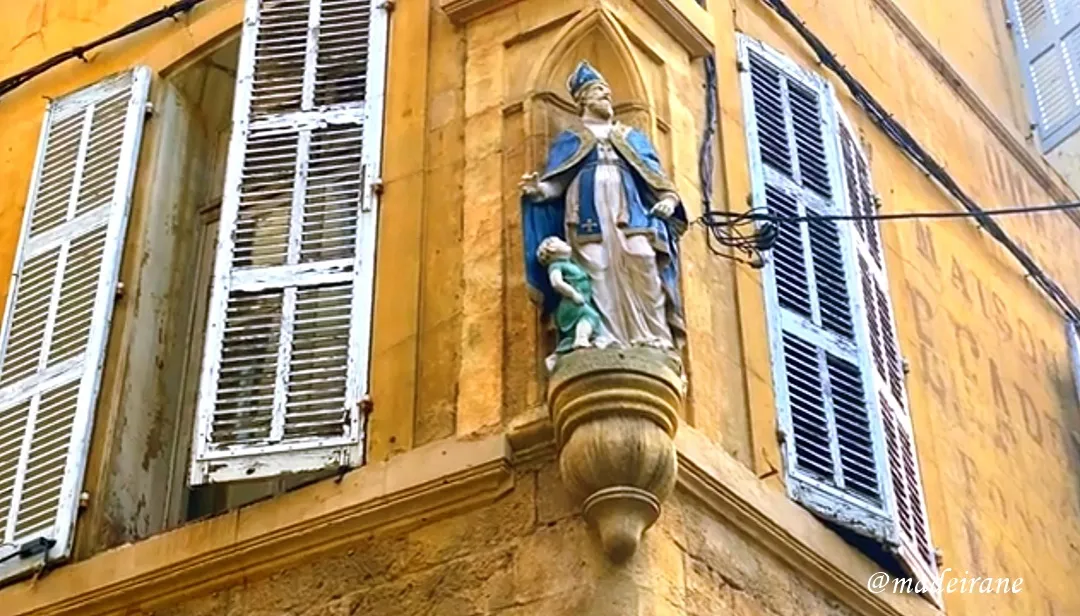
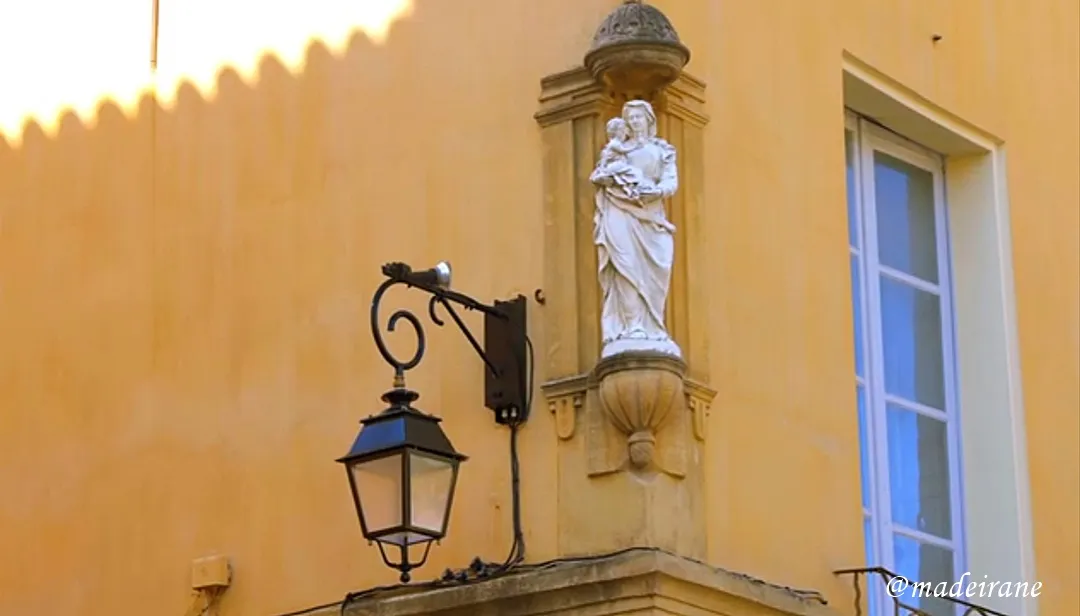
I also remember the pastel-colored rustic cottages with shuttered windows and the obligatory blank wall to keep out the cold mistral. The noble lines of ancient Roman ruins. The grandeur of medieval abbeys. The gray-blue cliffs. Olive groves, endless vineyards, orchards, gardens, vegetable gardens, fields. Signs with arrows and concise texts: wine, apricots, peaches, melons, plums, watermelons... Balconies of high-rise buildings draped with dark fabrics - just like nomadic homes.
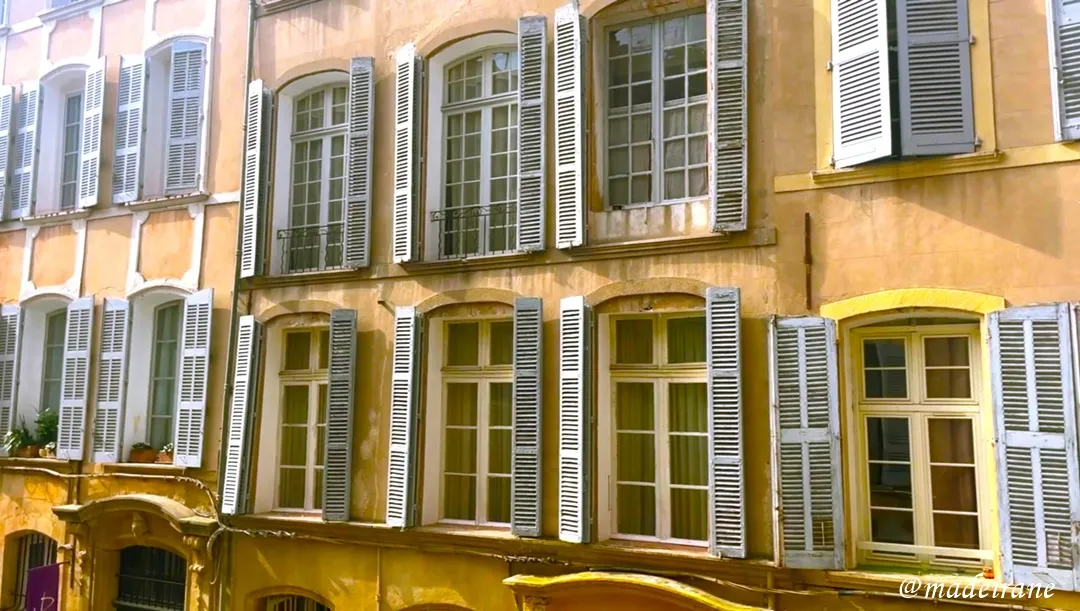
I had a deep sympathy for Aix-en-Provence from the very first minutes of my acquaintance with it. This sympathy was not hindered by the heat which I was frightened of. But despite the stable plus thirty-seven and above, I felt quite normal.
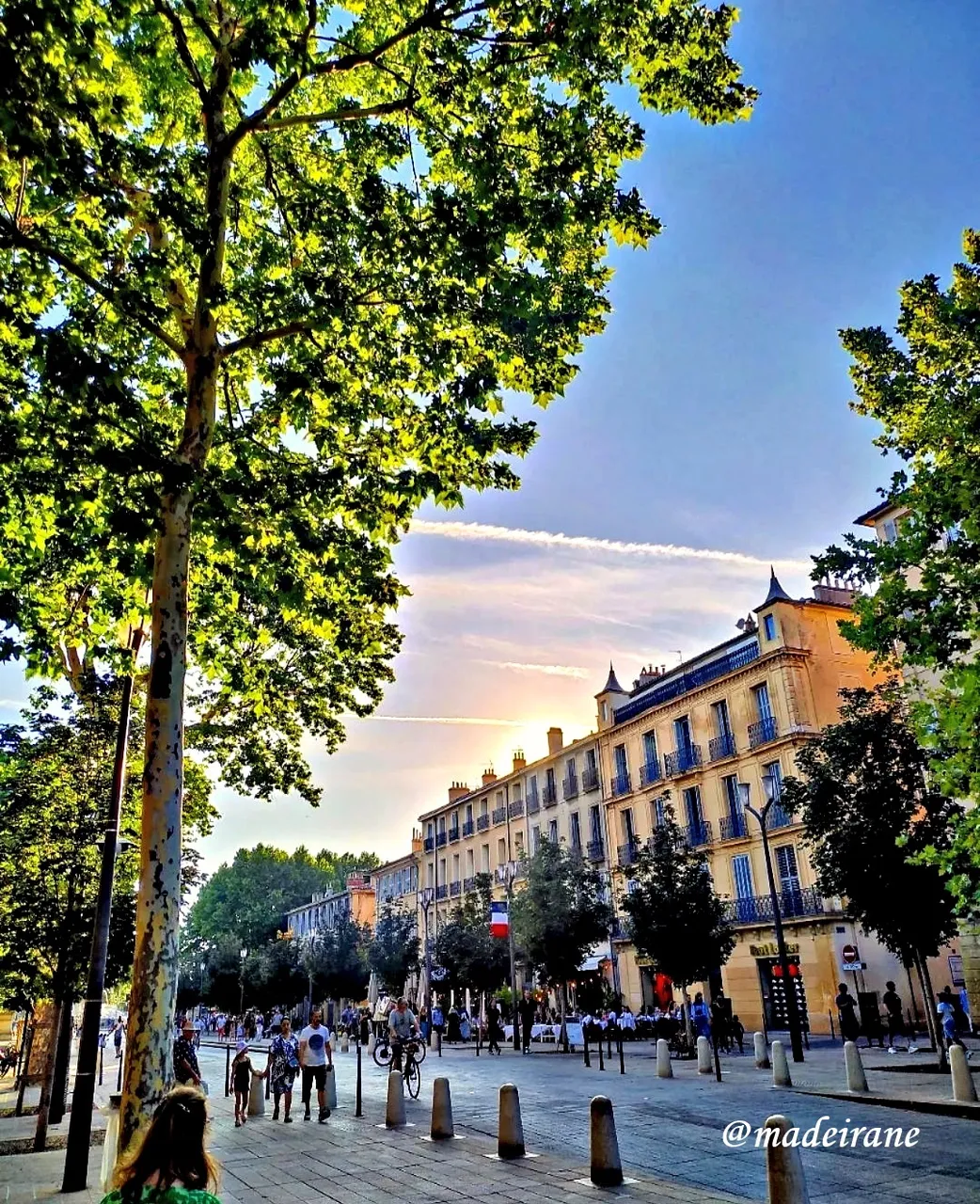
The Aix history
The city is mentioned in ancient chronicles since ancient times and, as its name suggests, it stands "on the waters". It means that the ancient Romans discovered several thermal springs in this place. By the way, those springs are still in use today. It was very unexpected for me to learn that Aix-en-Provence, not Marseille at all, was the capital of Provence from the 12th century until the French Revolution. At that time, Provence was an independent county. It only became part of France at the end of the 15th century. King Rene then ruled Provence, including Aix-en-Provence. Citizens refer to him as the patronage of arts and crafts. It was this period of his reign that left a noticeable mark on the history of Aix-en-Provence.
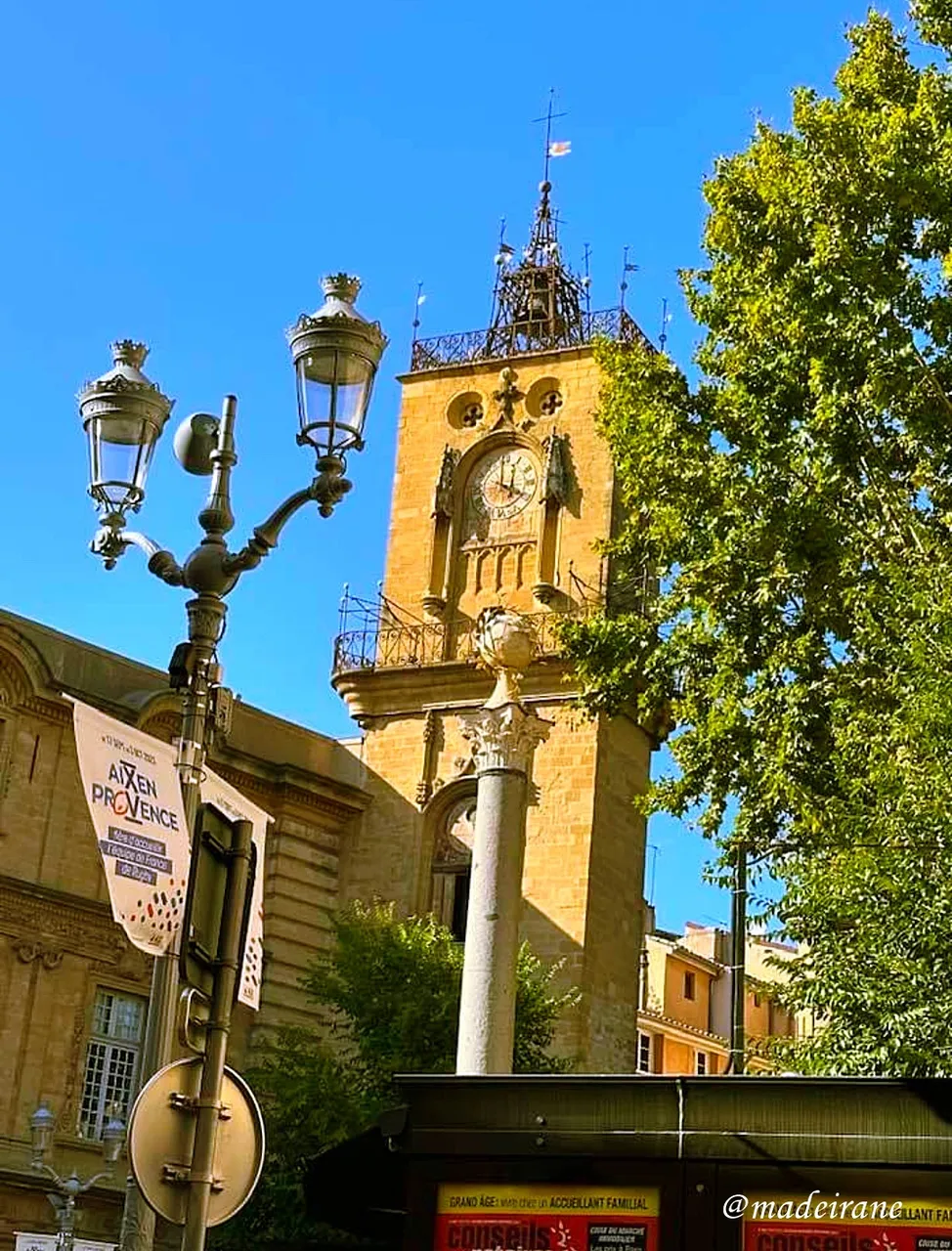
If we count the history of Aix from the first settlement of the Ligurian tribes, it will be 2500 years. In general, the Greeks, Romans, Franks, Lombards and Saracens have all made their mark on its territory.
What do I like about Aix-en-Provence?
Aix-en-Provence is a city with a deep sense of dignity and self-worth. Stylish, without any signs of intrusive cheap glitz. Aristocratic, but without aggressively flaunting luxury. And in spirit, something reminds of the old Paris of the 17th and 18th centuries, which, unfortunately, was damaged and lost.
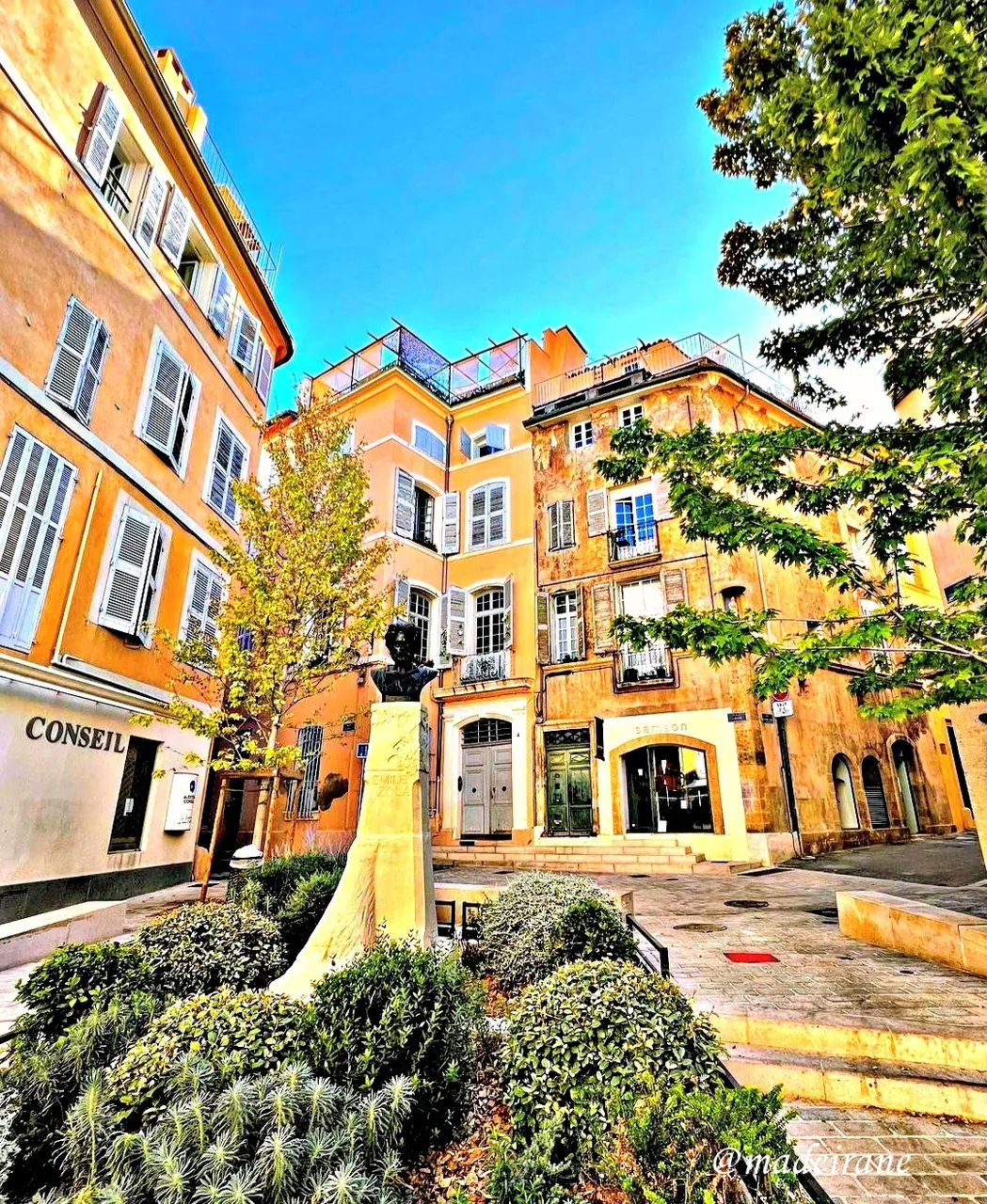
Mighty old plane trees, elegant sandstone houses in warm sunny colours with elegant wrought-iron balcony grilles. Boutiques, restaurants, shops, hotels. A colourful and not at all annoying market where you can buy bags and creams with lavender, lavender oil, Marseille soap, clothes, antiques and vintage items, towels embroidered with the symbols of Provence, and many other interesting things. And narrow lanes of charming streets stretching in different directions.
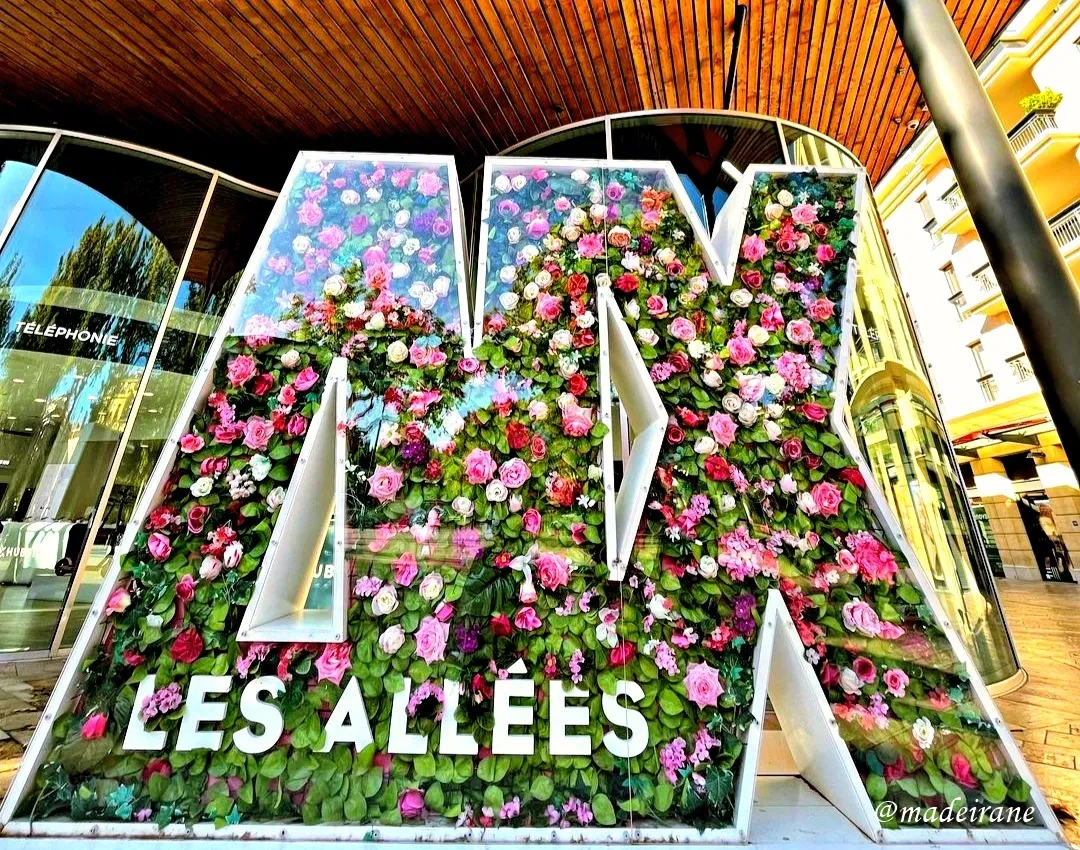
Rotonde fountain
We started our walk around the city from the starting point recommended by all guidebooks - from De Gaulle Square. The most monumental city fountain, the Rotonde Fountain, is installed there. Nearby there is a paid parking lot and a tourist information center, where you can get free maps of the historical center and surroundings of Aix.
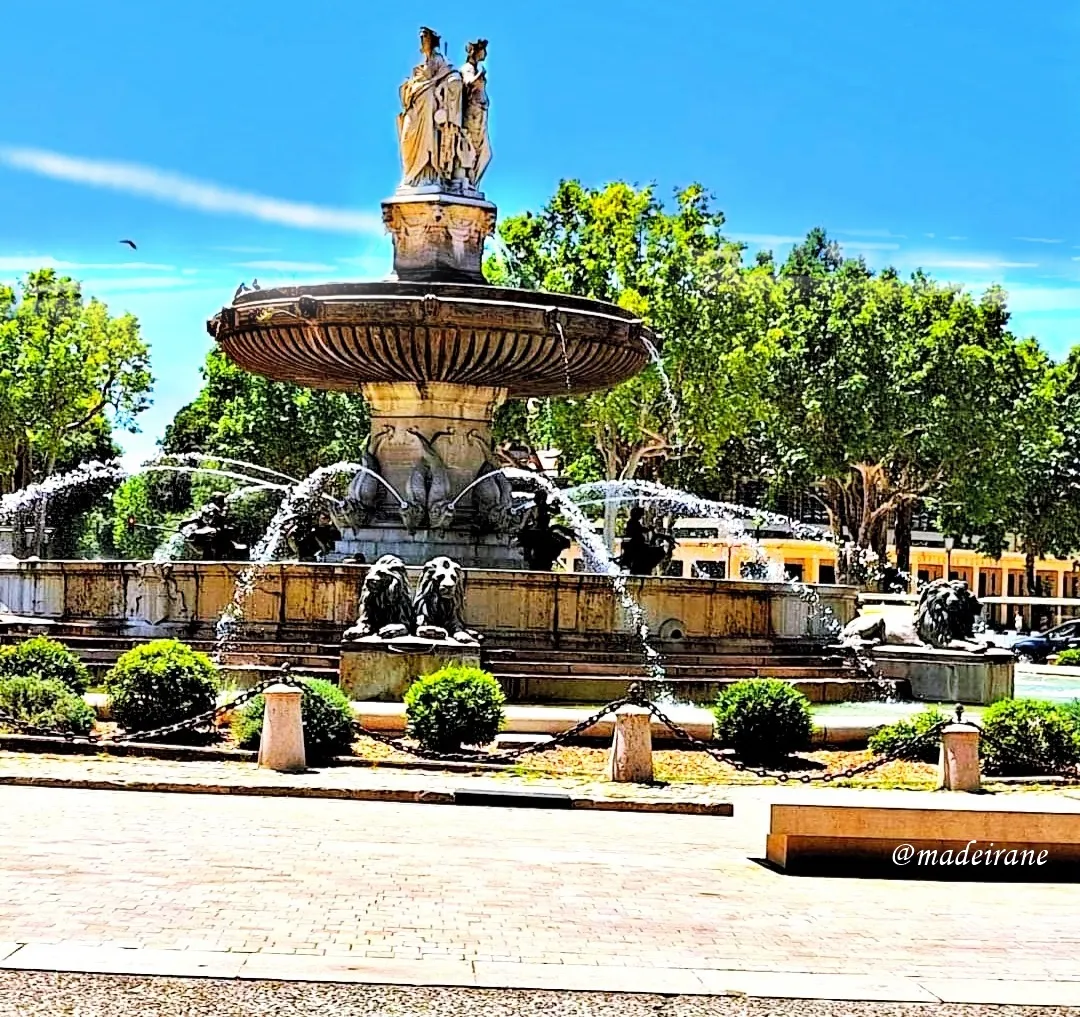
The Rotunda Fountain was designed in the 19th century. The idea of the sculptural group that decorates the upper part of the fountain is quite curious. The eyes of three marble ladies in antique clothes (and all of them were created by different sculptors) are turned in different directions. The lady symbolizing justice looks at the Boulevard Mirabeau. The lady "in charge" of commerce and agriculture keeps an eye on Avenue des Belges, which leads to Marseille. And Avenue Bonaparte, which leads to Avignon, is entrusted to the lady symbolizing the fine arts. Swans, lions and dolphins have been added to these three graces.

The Rotonde Fountain is undoubtedly beautiful, but I liked the other, less flashy, and at the same time, special city fountains, which give additional charm to the former capital of Provence.
From the Rotonde fountain we turned into the heart of the old Aix-en-Provence - along Boulevard Mirabeau.
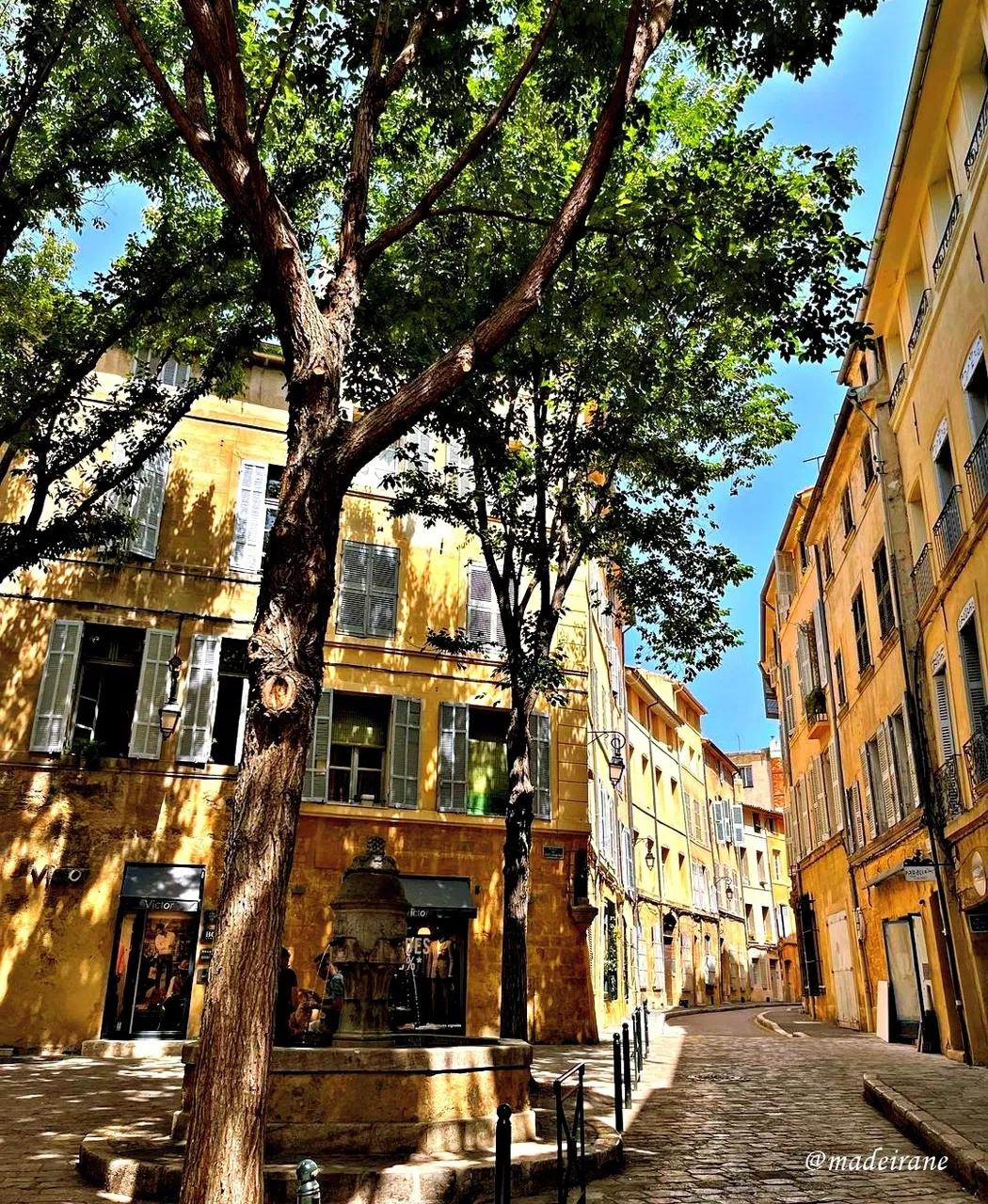
The city of a thousand fountains
Aix-en-Provence is characterised as "the city of a thousand fountains". However, if we look at the realities of our days, there are no more than half a dozen fountains from the category of must-see, marked on the tourist map. Another common stamp on the description of Aix is "the city of Cézanne". There is nothing to object to this: one of the whales of post-impressionism was born and died here.
Since tourists usually start their walk along Boulevard Mirabeau from the Rotonde fountain, the first fountain they see on their way is referred to in many guidebooks as the Nine Cannons Fountain.
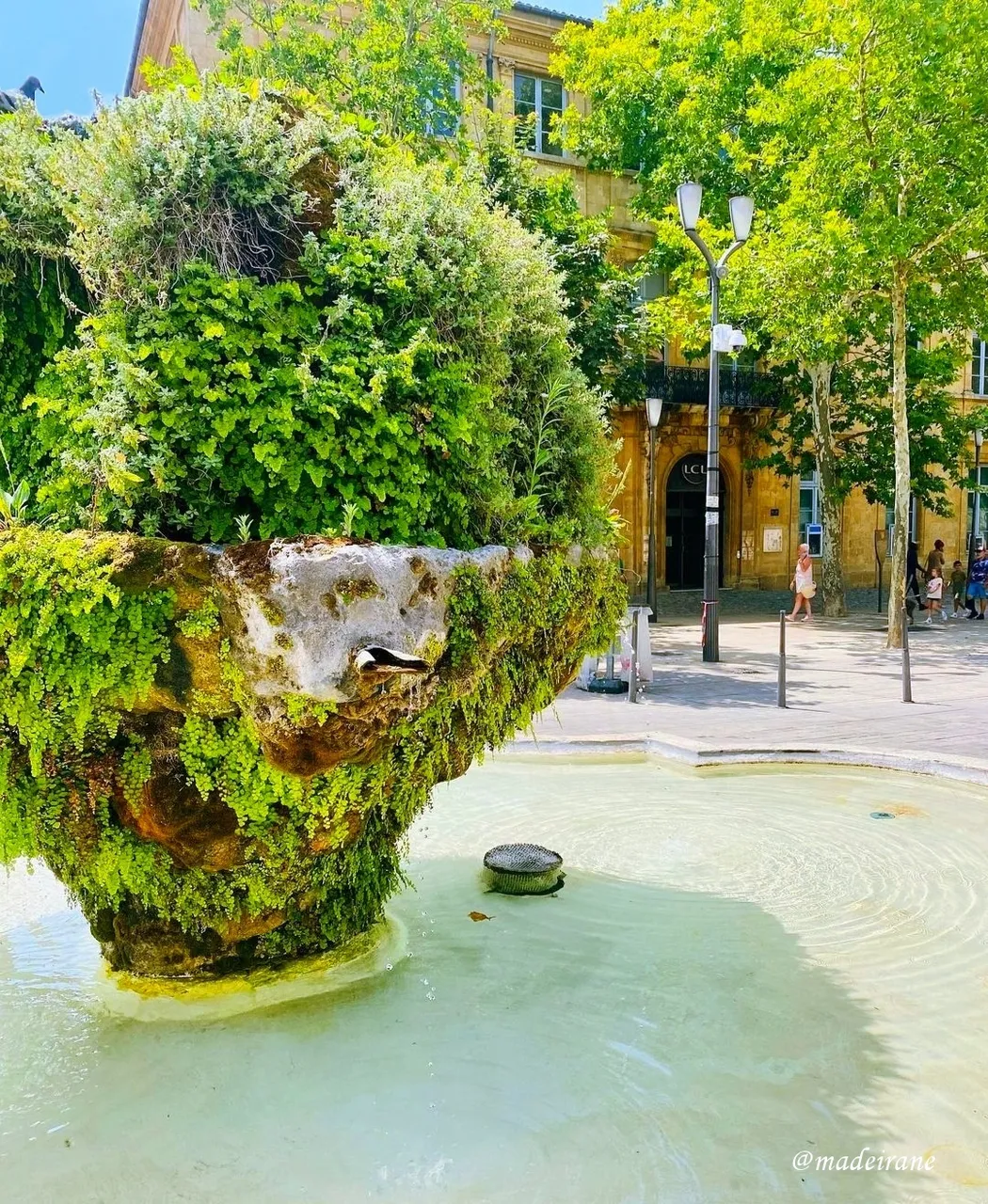
Do not search for any militaristic roots in this name. It was given for the principle of the fountain's operation: for the water coming out of nine pipes. The French word "canon" has many meanings, including not only cannon, but also pipe. It was built in the XVII century in the place of another fountain, from which they used to water the cattle. And the main consumers of water from the current fountain were local nuns.
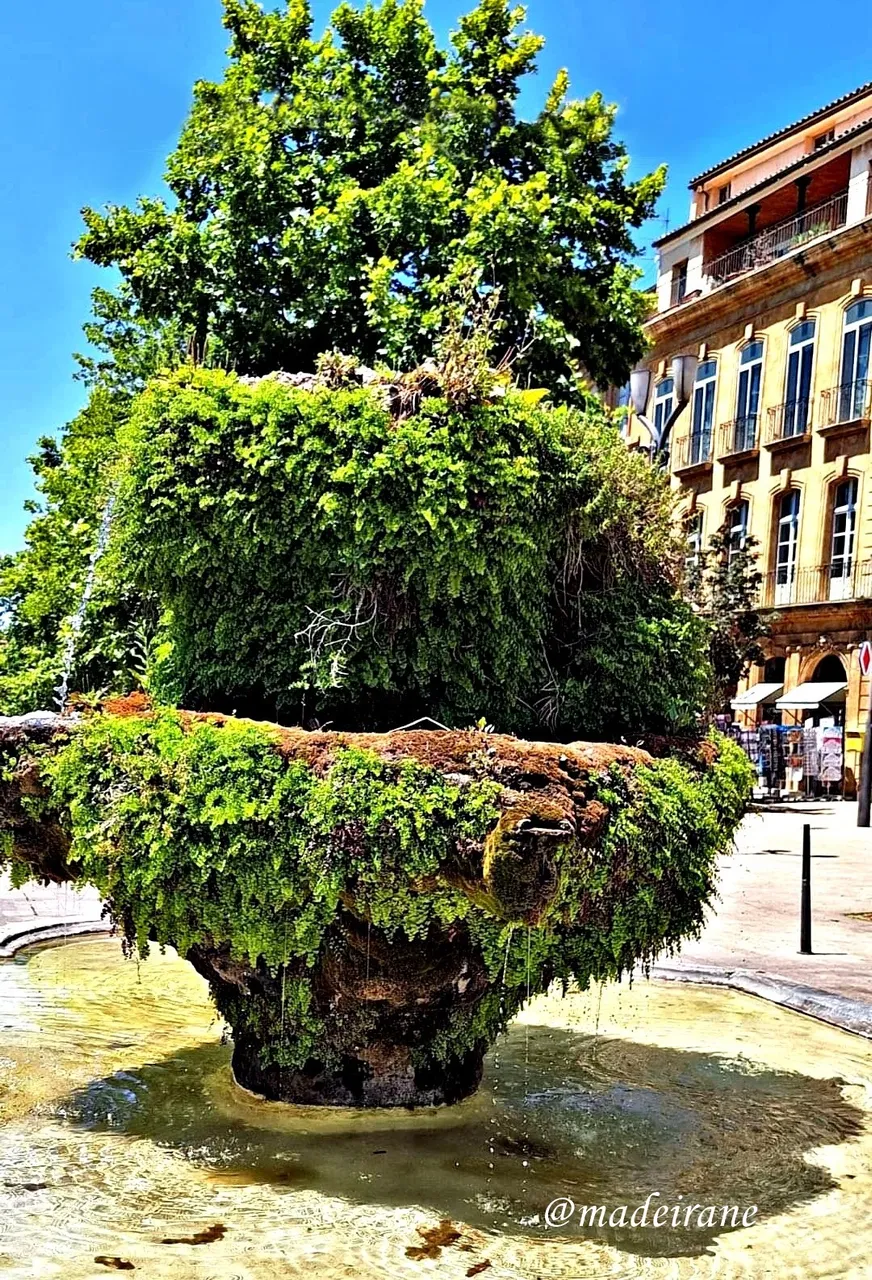
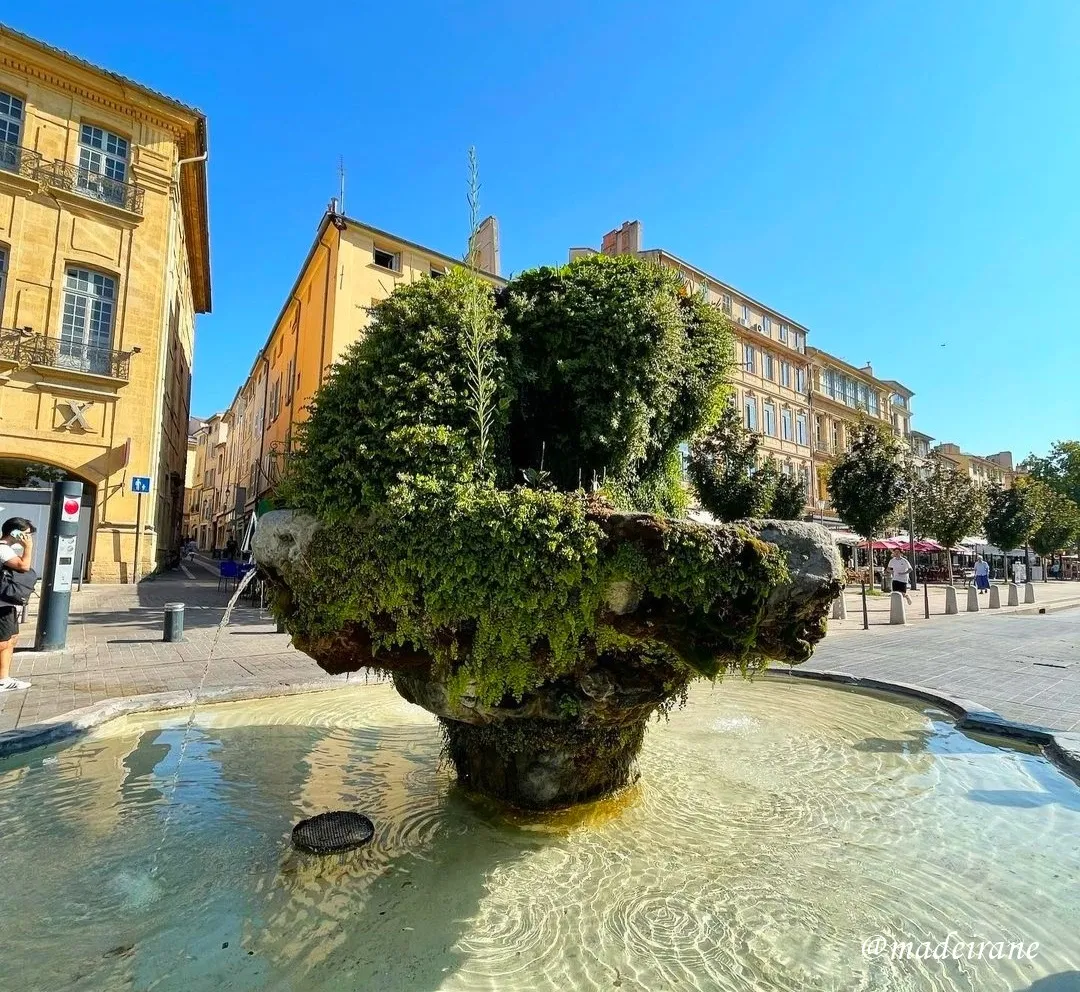
The most exotic and mesmerising fountain in Aix-en-Provence is the Mossy Fountain. A huge green ball of thick moss. The water gushing from the fountain is thermal and during cooler periods of the year, a cloud of vapour envelops it. The sculptures are buried under the moss, as in the case of the previous fountain, but only experts are likely to know and remember what they look like.
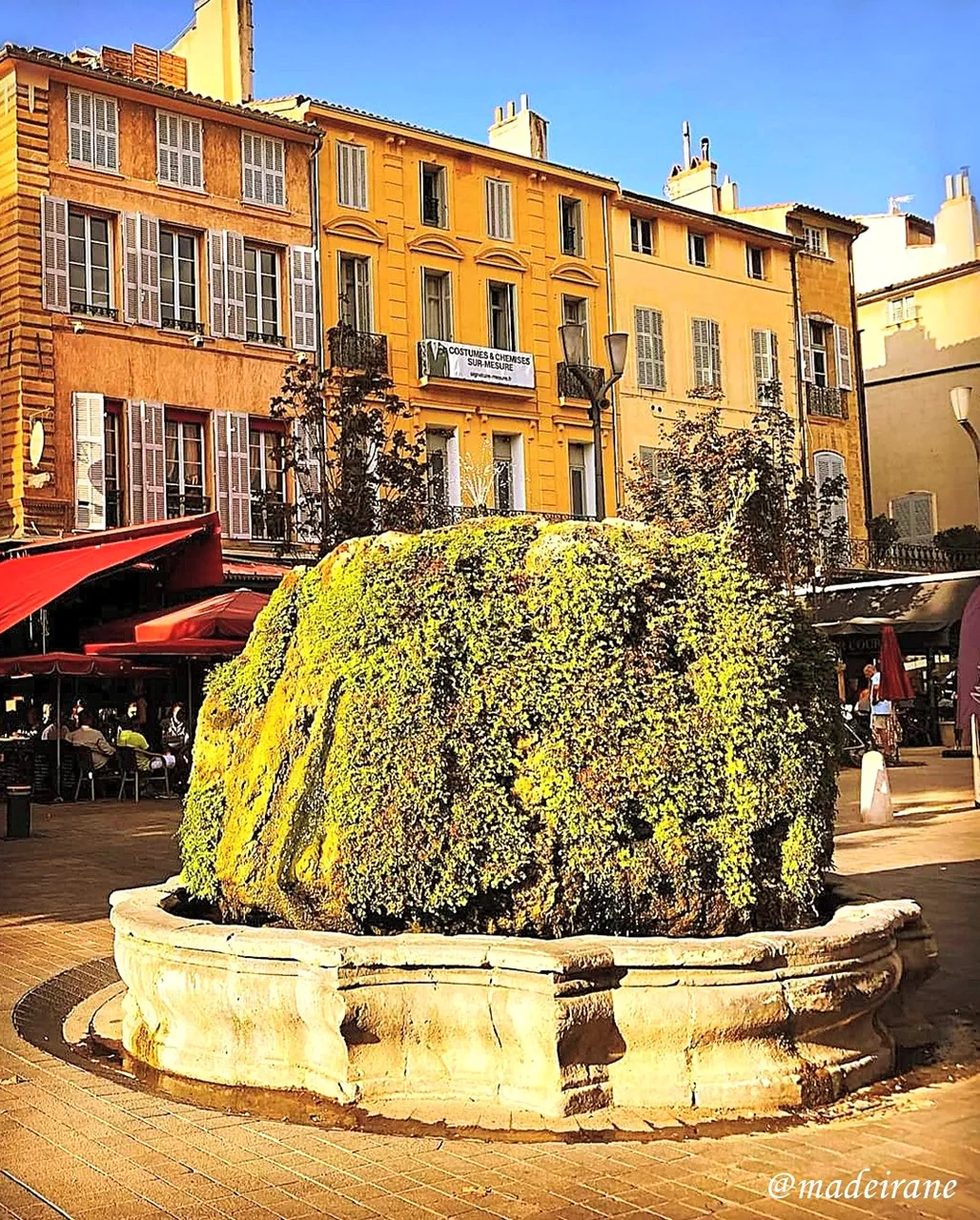
Formally, the fountains of Aix-en-Provence are unlike any other. No spectacular sculptures, no exquisite decoration, no elaborate patterns on the nozzles. But these centuries-old green shells, with their jets of thermal water gushing out from underneath, the palpable magic of a deep, awe-inspiring antiquity, instantly captivate the soul.
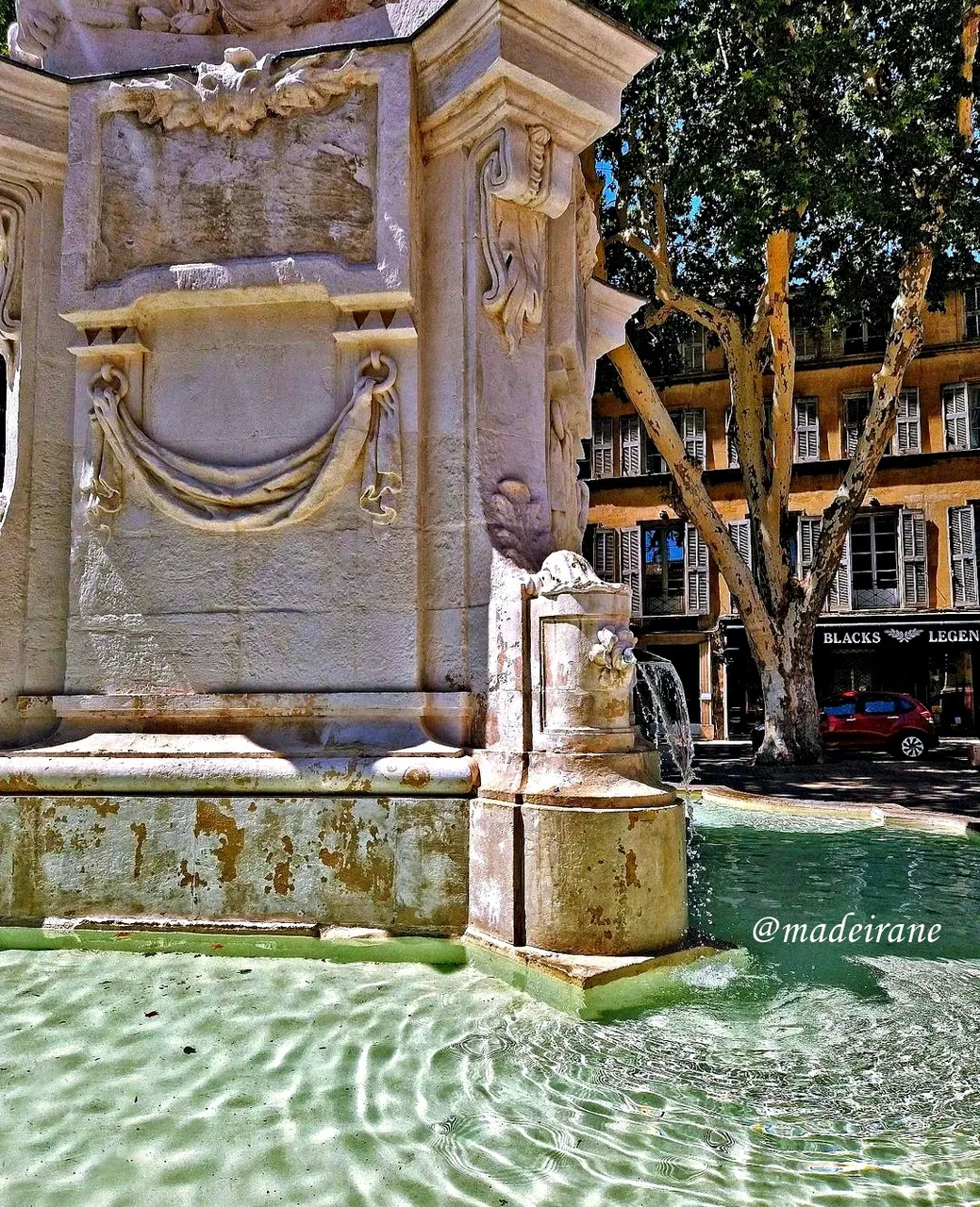

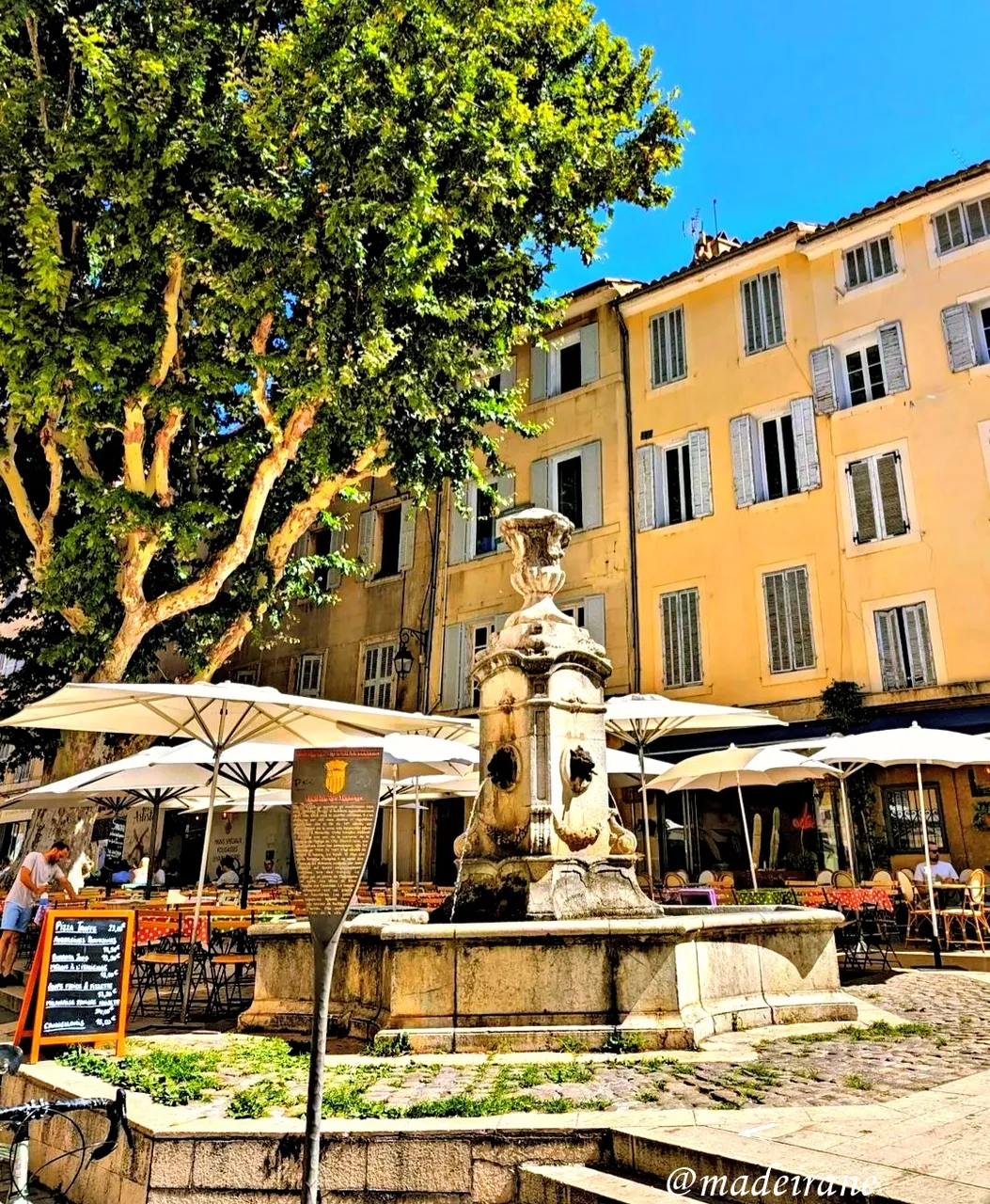
Further along the boulevard you will find another interesting fountain, the King Rene Fountain with its statue. His rule turned Aix-en-Provence into a major commercial and university centre of that time. Aix-en-Provence, by the way, is still considered one of the most student cities in France. It was under René that nutmeg and almonds began to be grown in Provence on a large scale. The last troubadour king René surrounded himself with a brilliant court, patronised poets, artists, musicians, and loved to organise colourful multi-day festivals and processions.
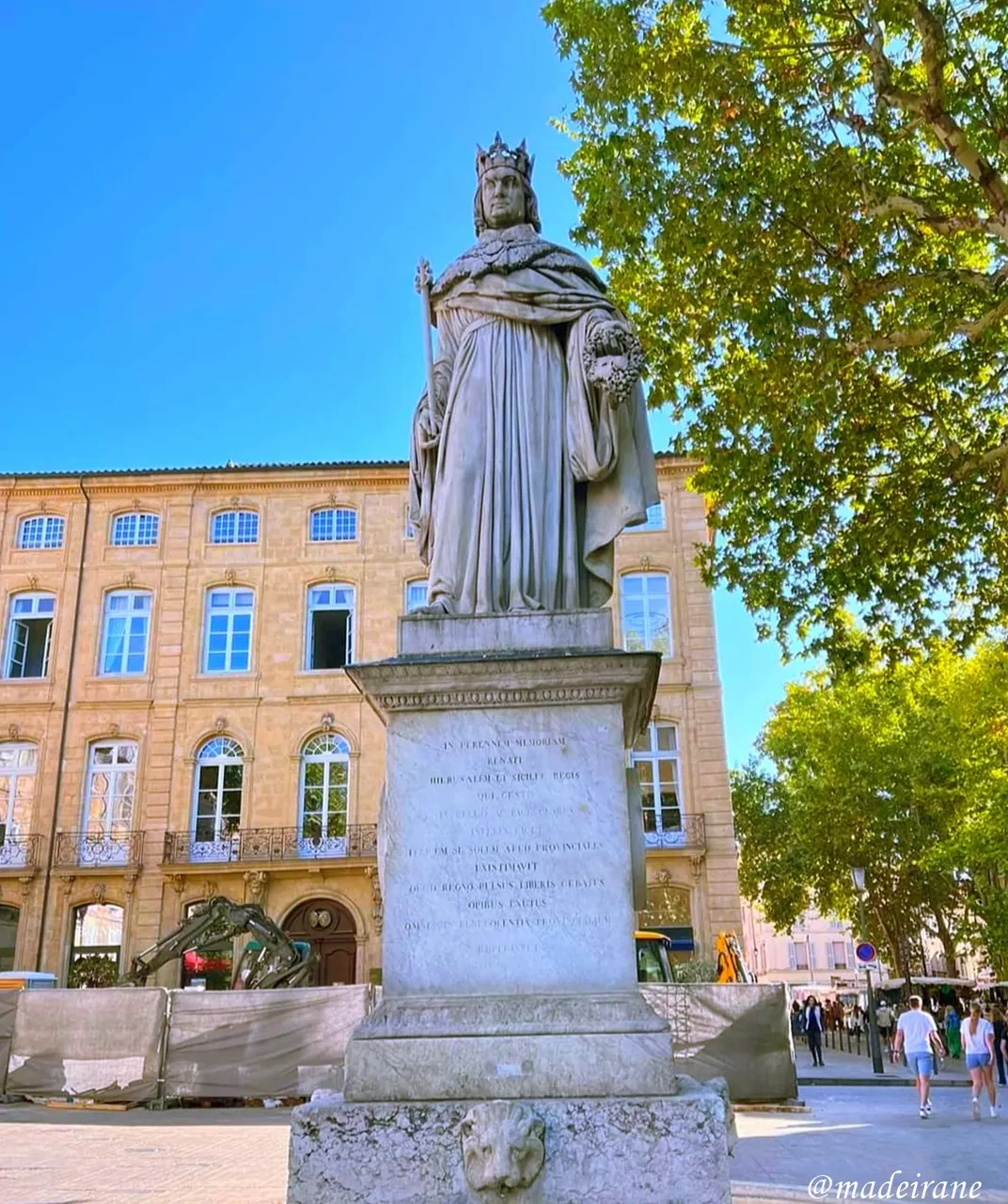
And thanks to the same René, in Aix-en-Provence a speciality delicacy appeared - calissons, candied almonds with candied fruit and almond glaze. This delicacy was first created for a royal wedding as a gift for the future queen.
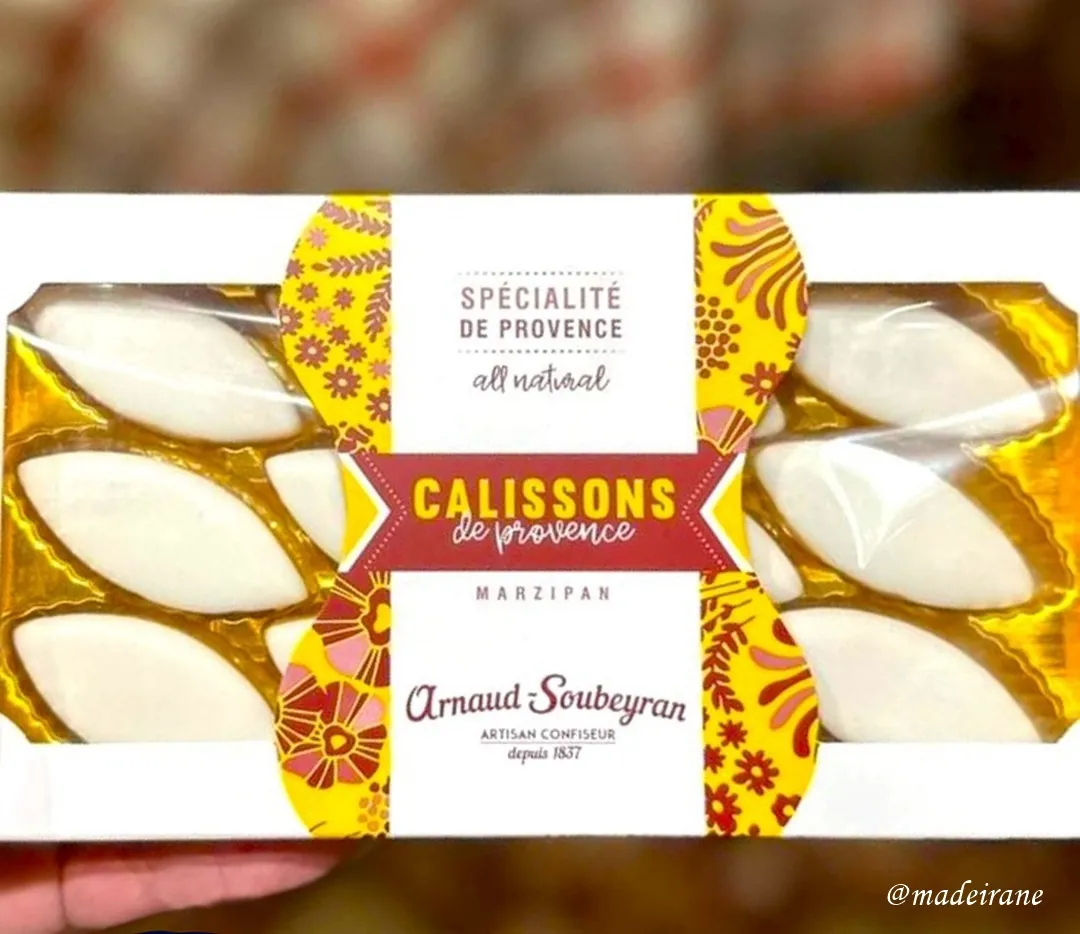
Gothic architecture
A city like Aix-en-Provence simply cannot be short of beautiful Gothic architecture.
The first address we went to for the Gothic was the Mazarini Quarter. Cardinal Giulio Mazarini, who was severely criticised in Dumas's novels, added this venerable quarter to the city map. No, not Cardinal Giulio Mazarini himself, but the Cardinal's brother Michel, who was Archbishop of Aix at the time.
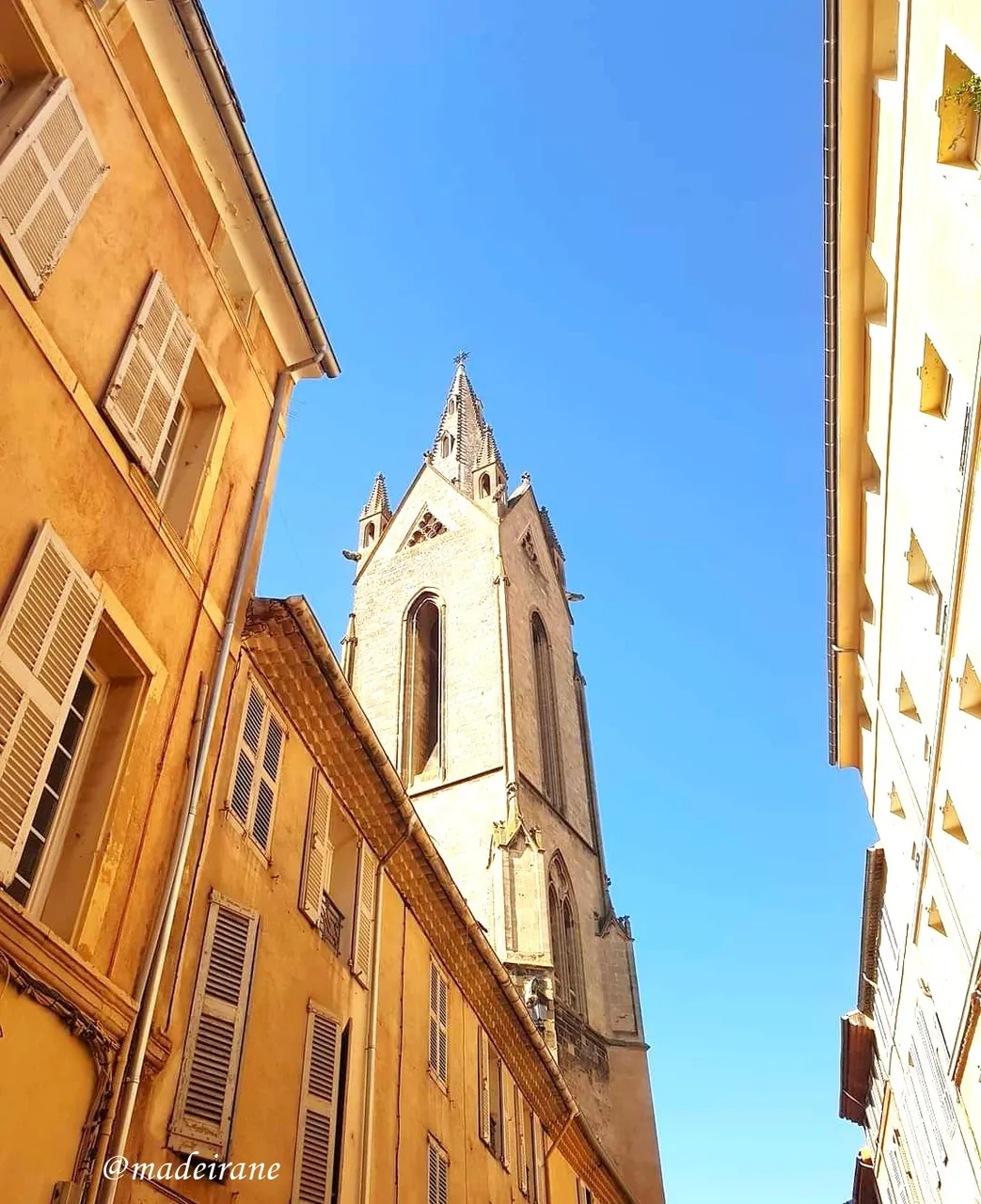
The purpose of our visit to this quarter was one of the oldest Gothic churches in Provence, the Church of St John of Malta, easily recognisable by its bell tower, which seems to be striving to break free from the tight embrace of the neighbouring houses. This almost 70 metre long "pencil" is considered to be the longest in Provence.
Famous sights of Aix-en-Provence
Inside the church, beautiful stained glass windows shine in the sun. We found a wonderful collection of paintings there. In fact, it wasn't only the Knights of Malta and the Gothic style that brought me to this church. The third reason for my visit was Delacroix's painting "The Crucifixion", which was donated to the church in the late 1980s.
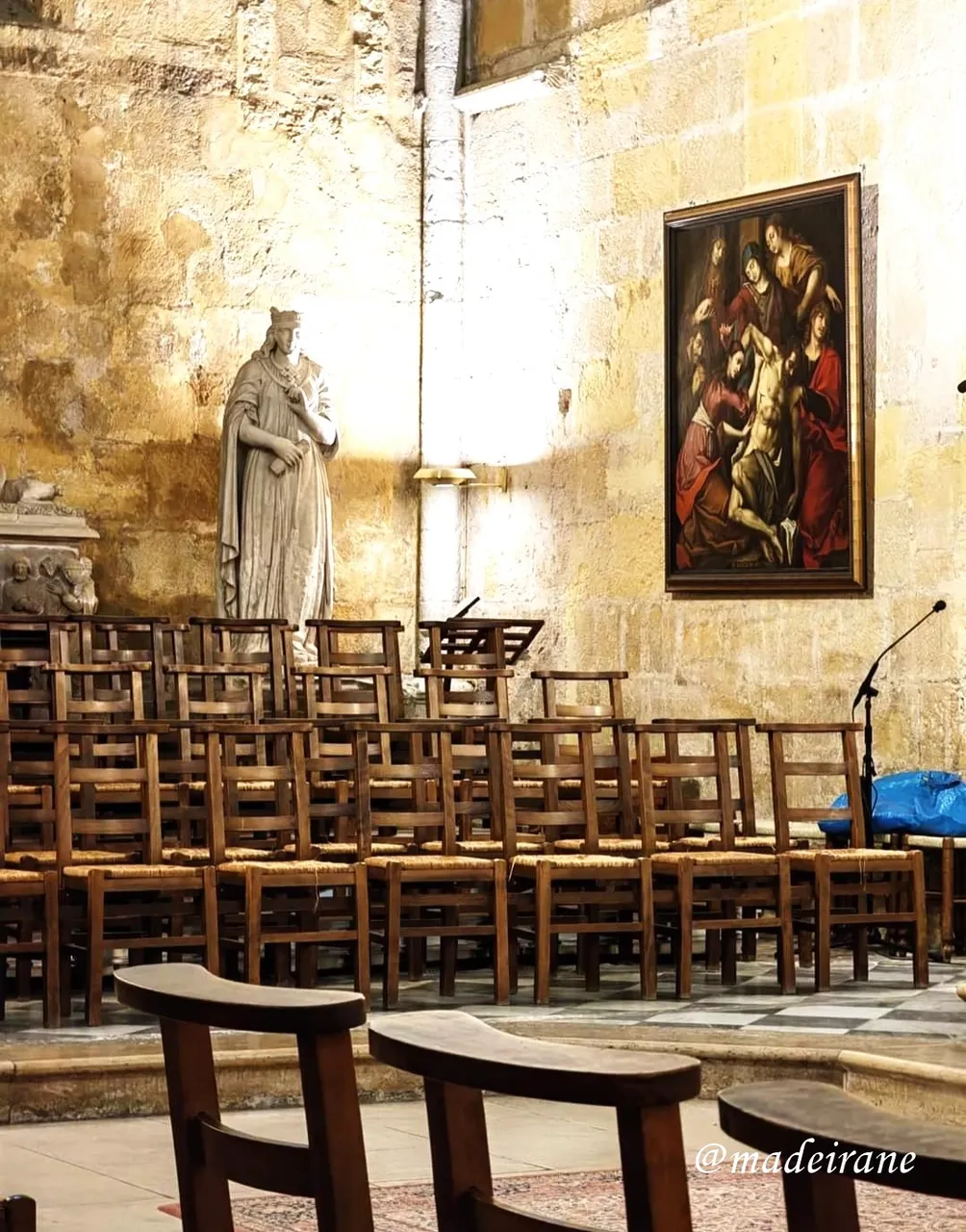
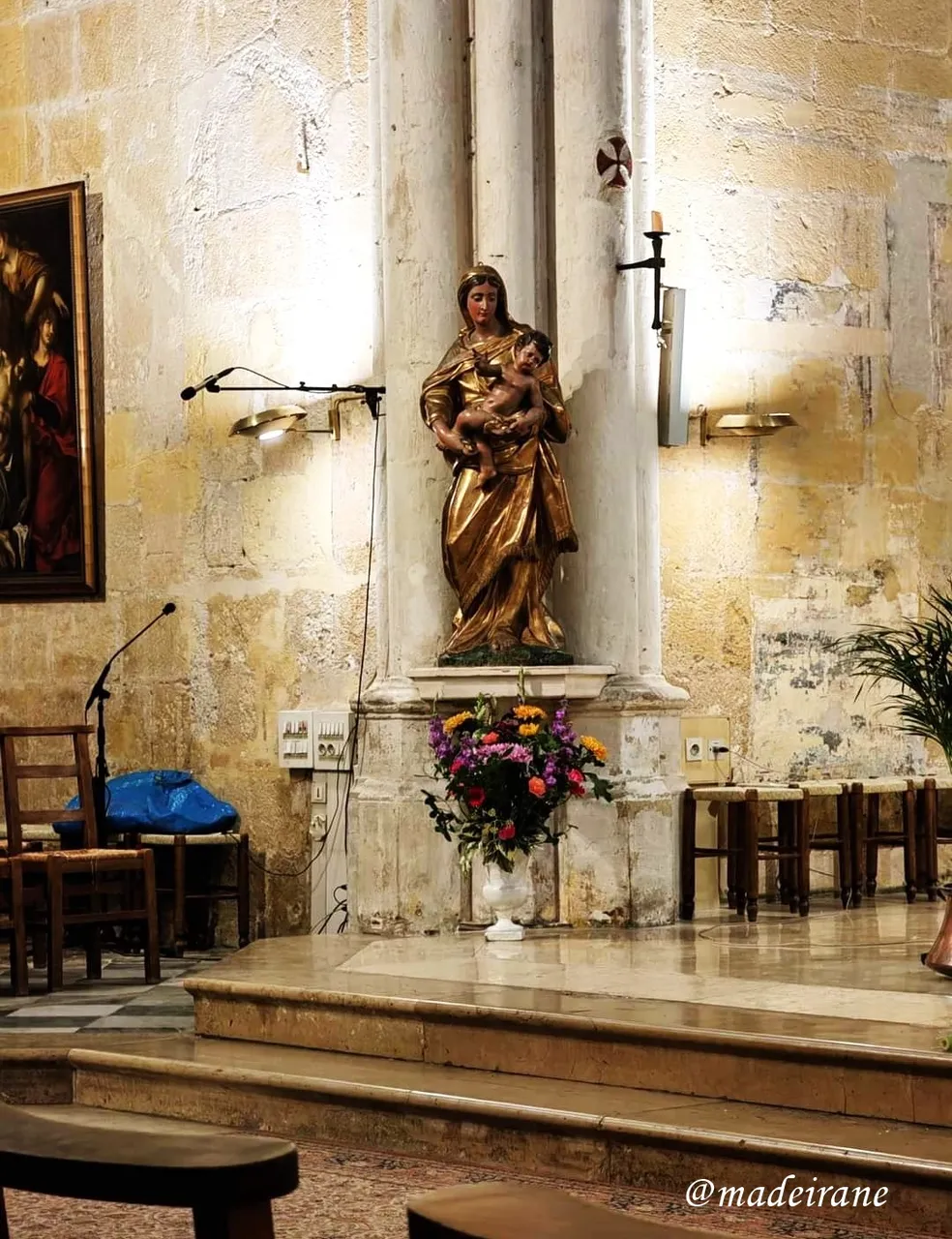
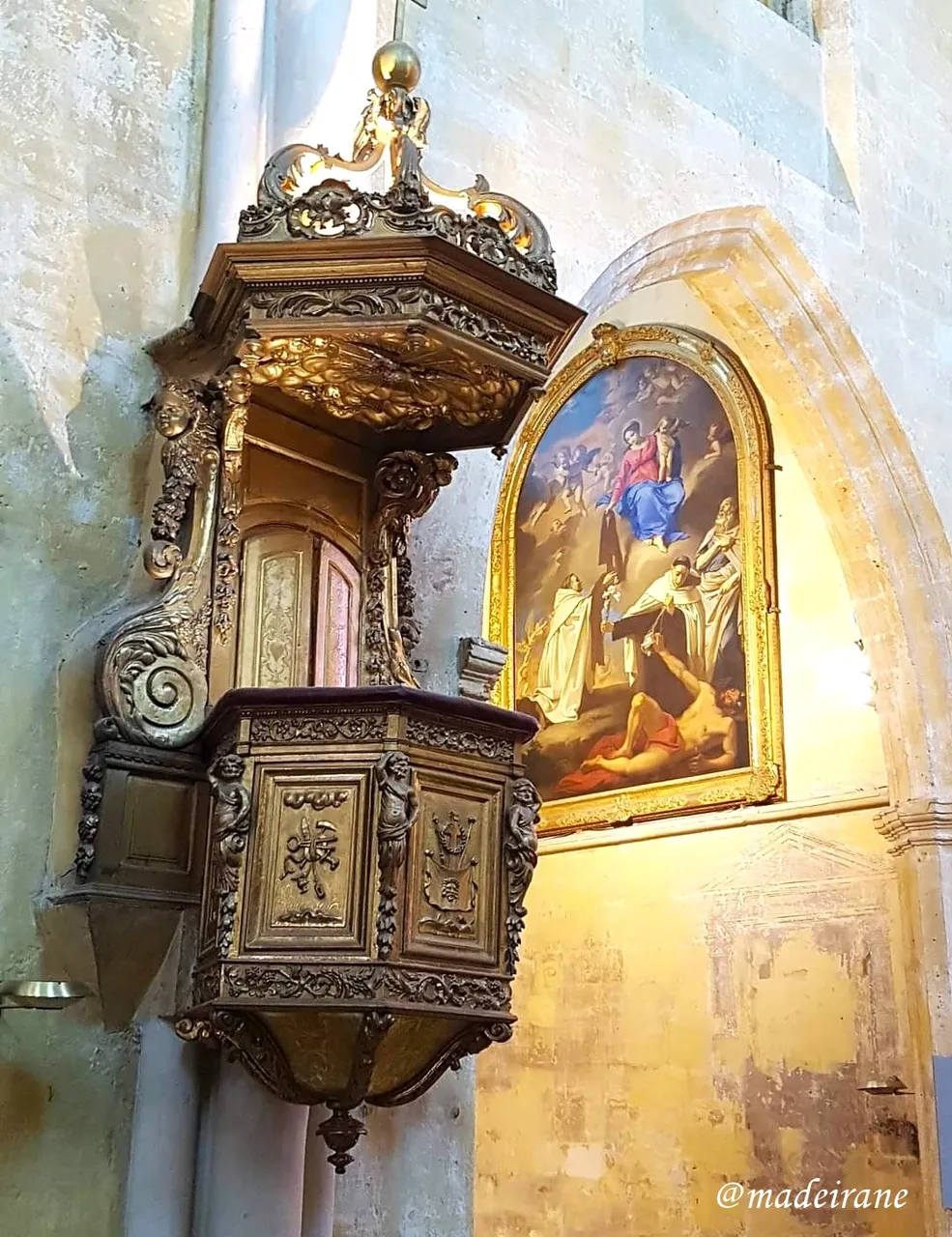
Near the church, in the Place des Precheurs, is another picturesque market offering vegetables, fruits, the famous Provencal herbs and other various spices.
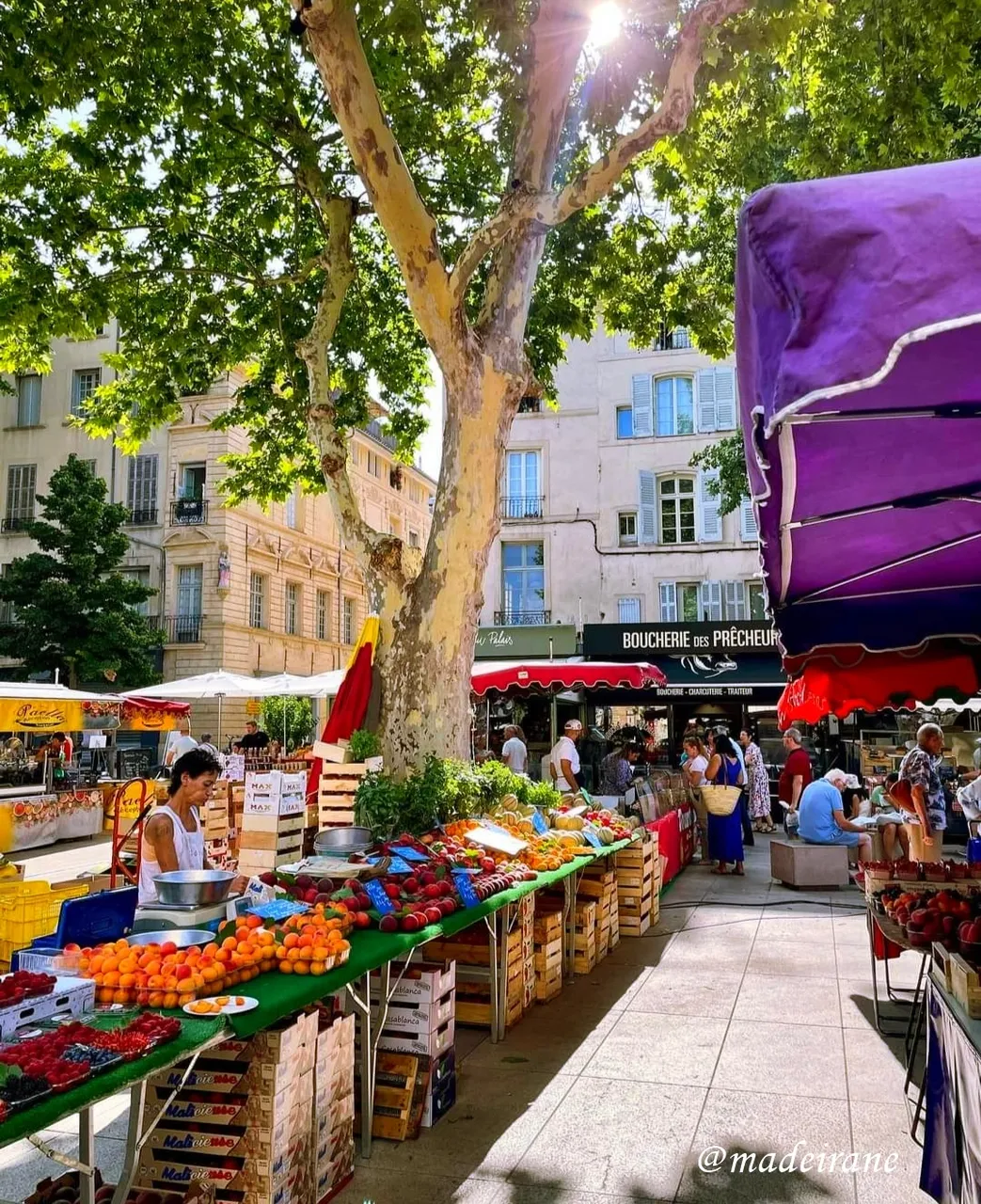
One of the most beautiful squares in Aix-en-Provence is Albert Square, designed in the best traditions of Paris and Italy for the wealthy and influential citizen after whom it is named. In order to realise his vision, Mr d'Albert had to buy up all the houses on the site.
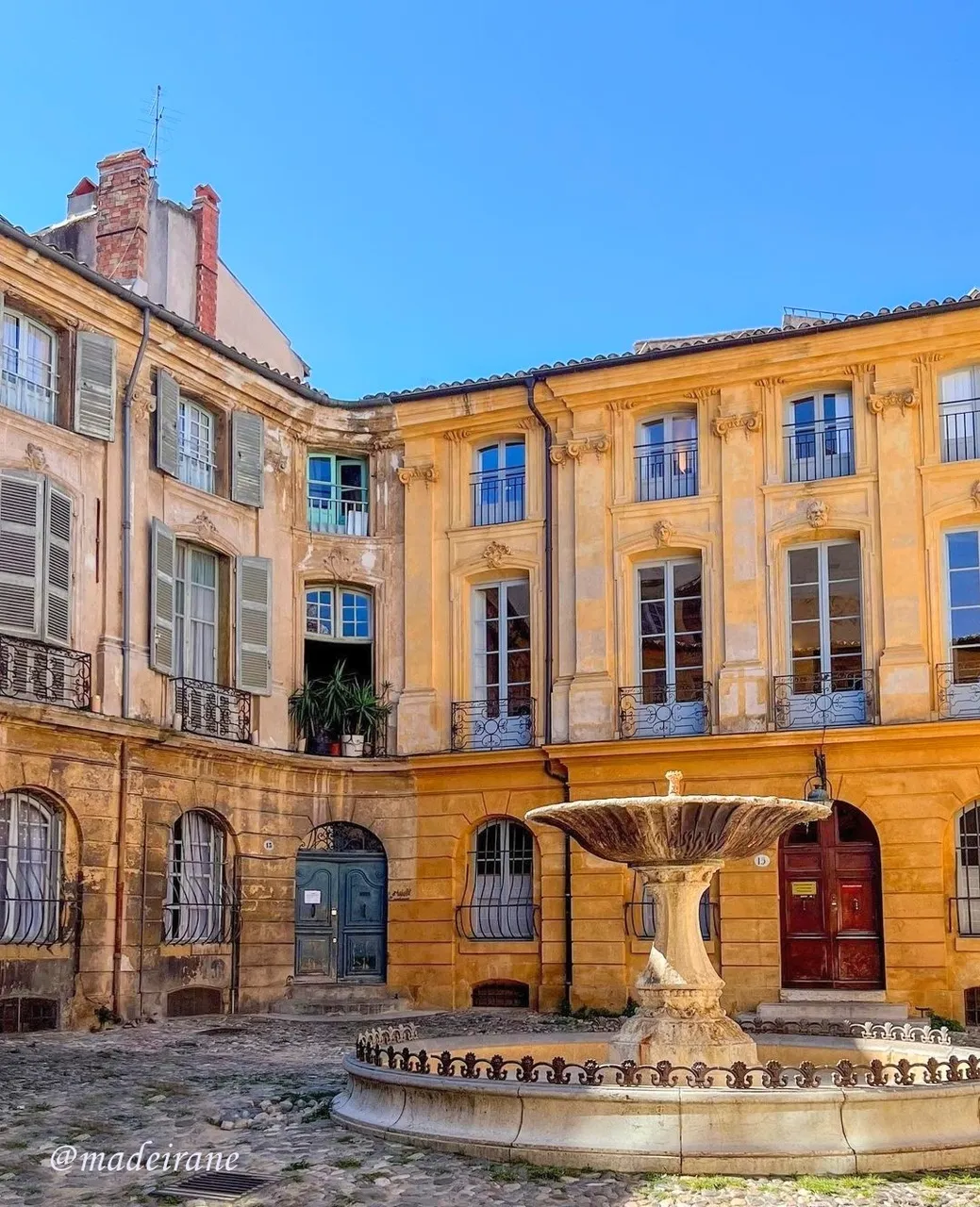
Baroque buildings with Rococo decorations built in the XVIII century look at the square from three sides. And the elegant but covered with moss fountain appeared many decades later - after the death (or rather, after the murder) of the owner of the square.
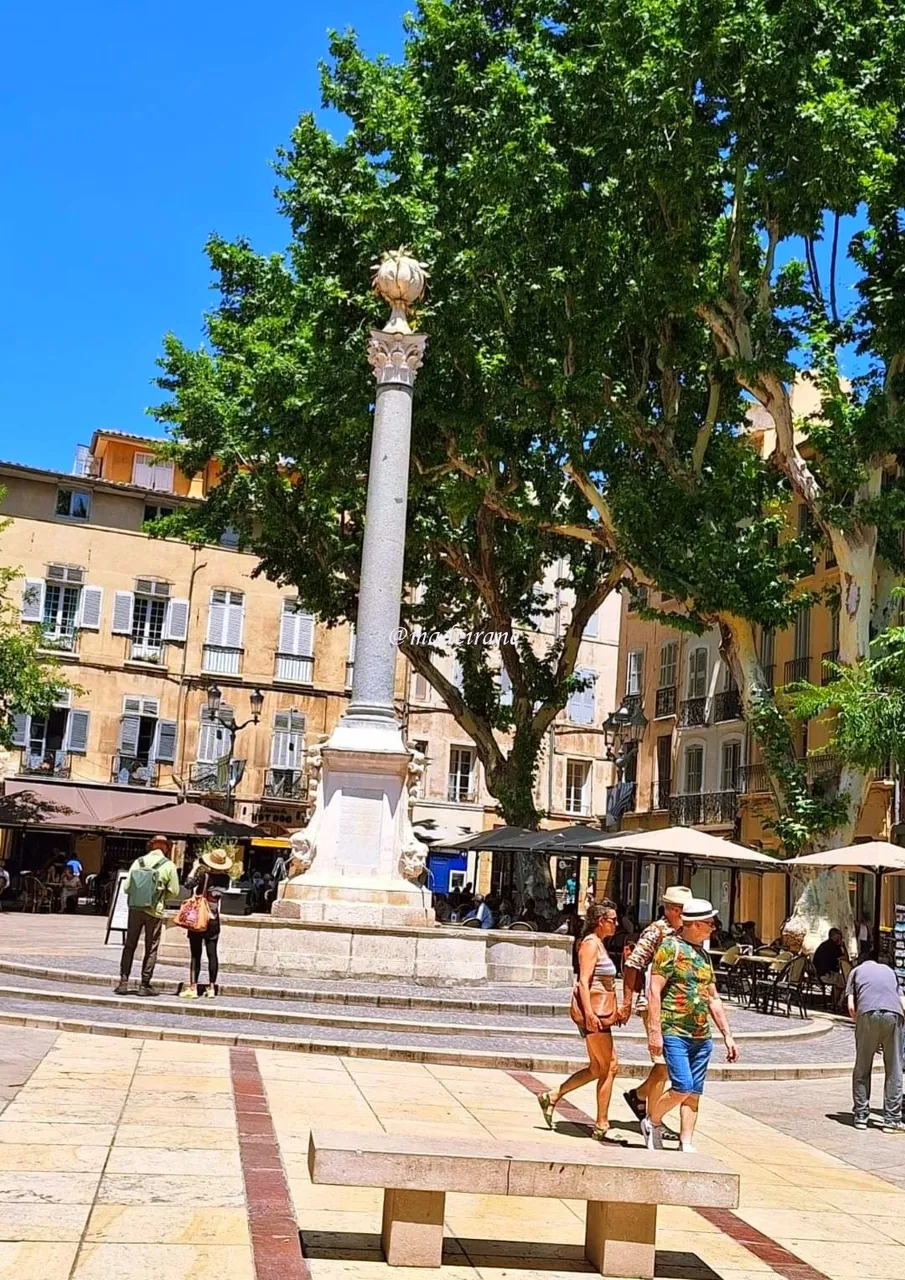
And again we dive into the maze of lovely streets of Aix-en-Provence. One of them beckons a beautiful old watchtower with a clock and a bell on its roof. We were heading towards the Town Hall, went through Rishelm Square, where another market was buzzing. On Town Hall balcony, the flag of Provence flies alongside the flags of the European Union and France. Like the tower, the town hall dates back to the 17th century.
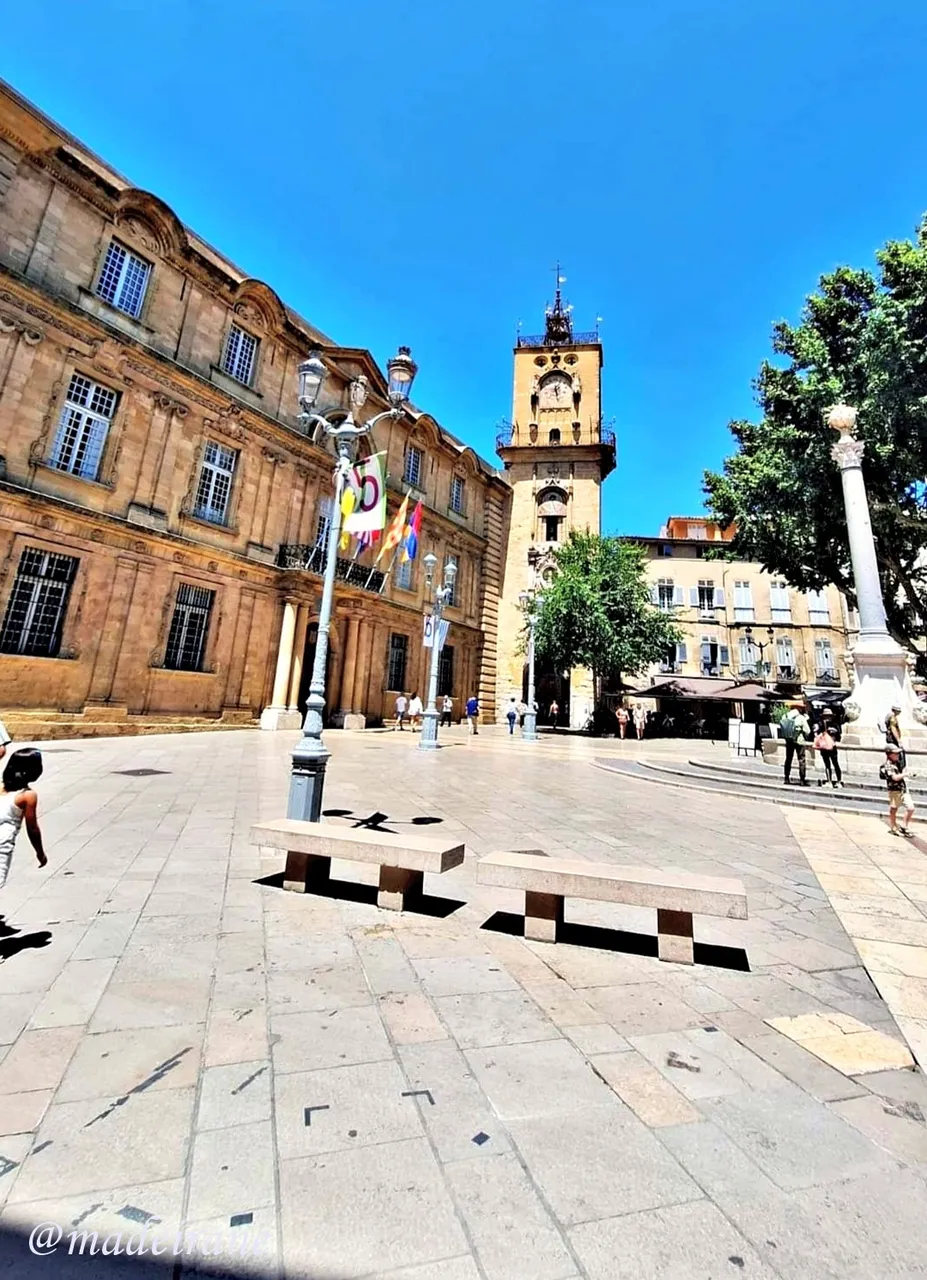
Next door to the Town Hall is the impressive building of the former grain exchange with allegorical figures on the pediment, symbolizing the Rhone River and the Durants. And if not for prior reading of the literature, I would have mentally "placed" a stock exchange in this building.

I love the bright and warm colour of the sandstone from which Aix's buildings are made. Here and there we saw moving figures of the Virgin Mary and various saints.
Cathedral of the Holy Saviour
I will use the word 'stunning' many times when talking about the local Cathedral of the Holy Saviour. It is truly amazing that Aix-en-Provence has preserved a treasure where all the architectural styles existed from the fifth to the seventeenth centuries, i.e. the different phases of the cathedral's construction, are alive and well. These include Romanesque, Gothic and Baroque, but also the legacy of Ancient Rome in the form of a fragment of wall and columns, which can be seen in the baptistery of the cathedral.
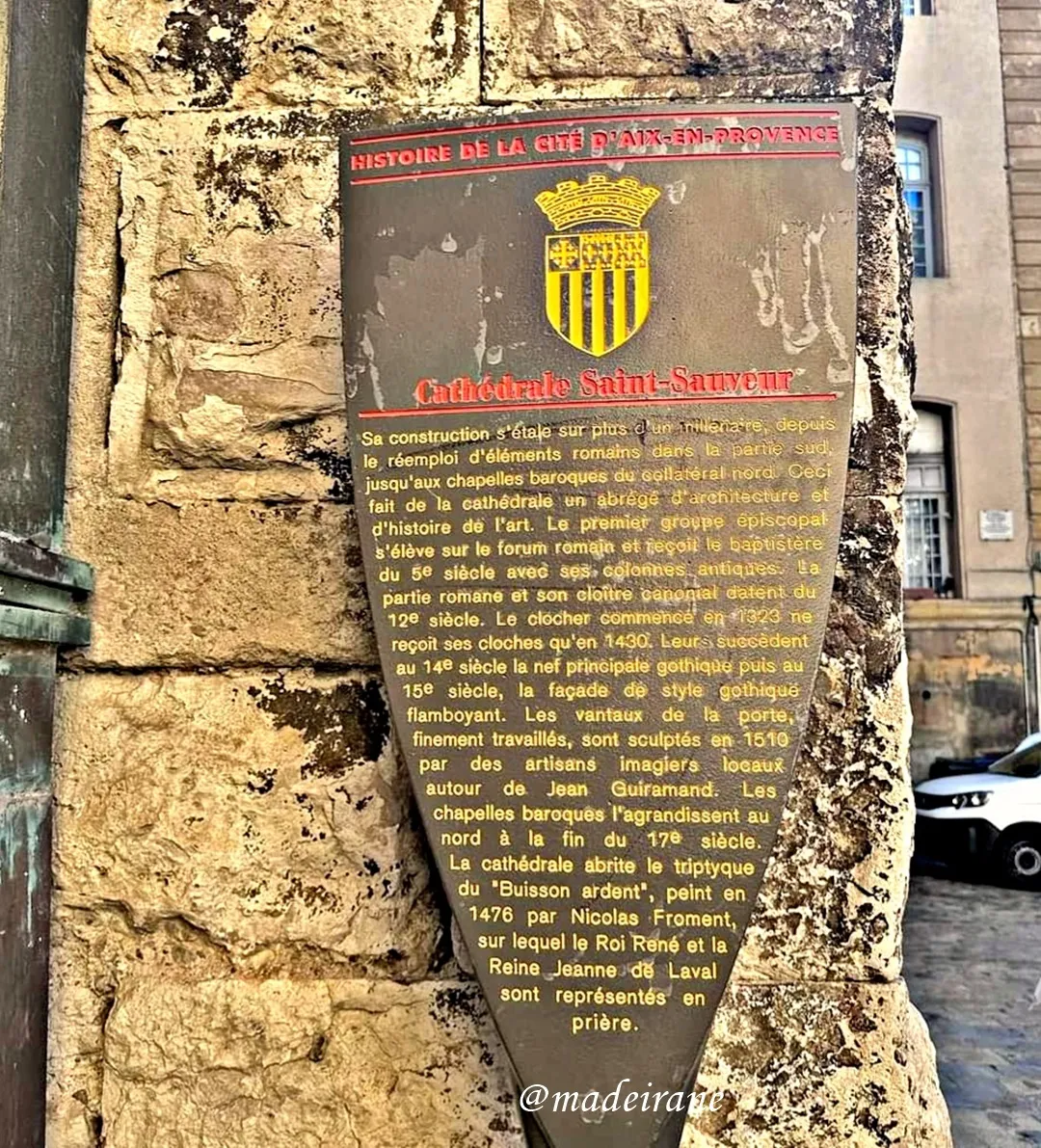
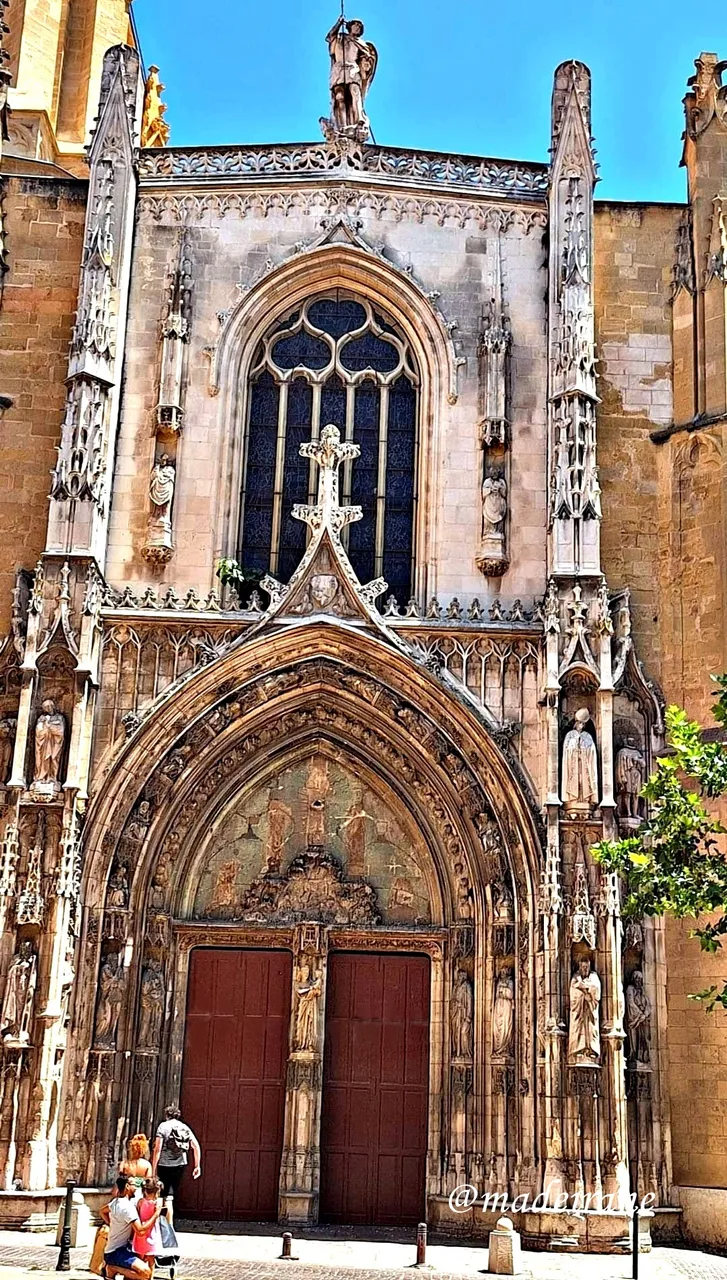
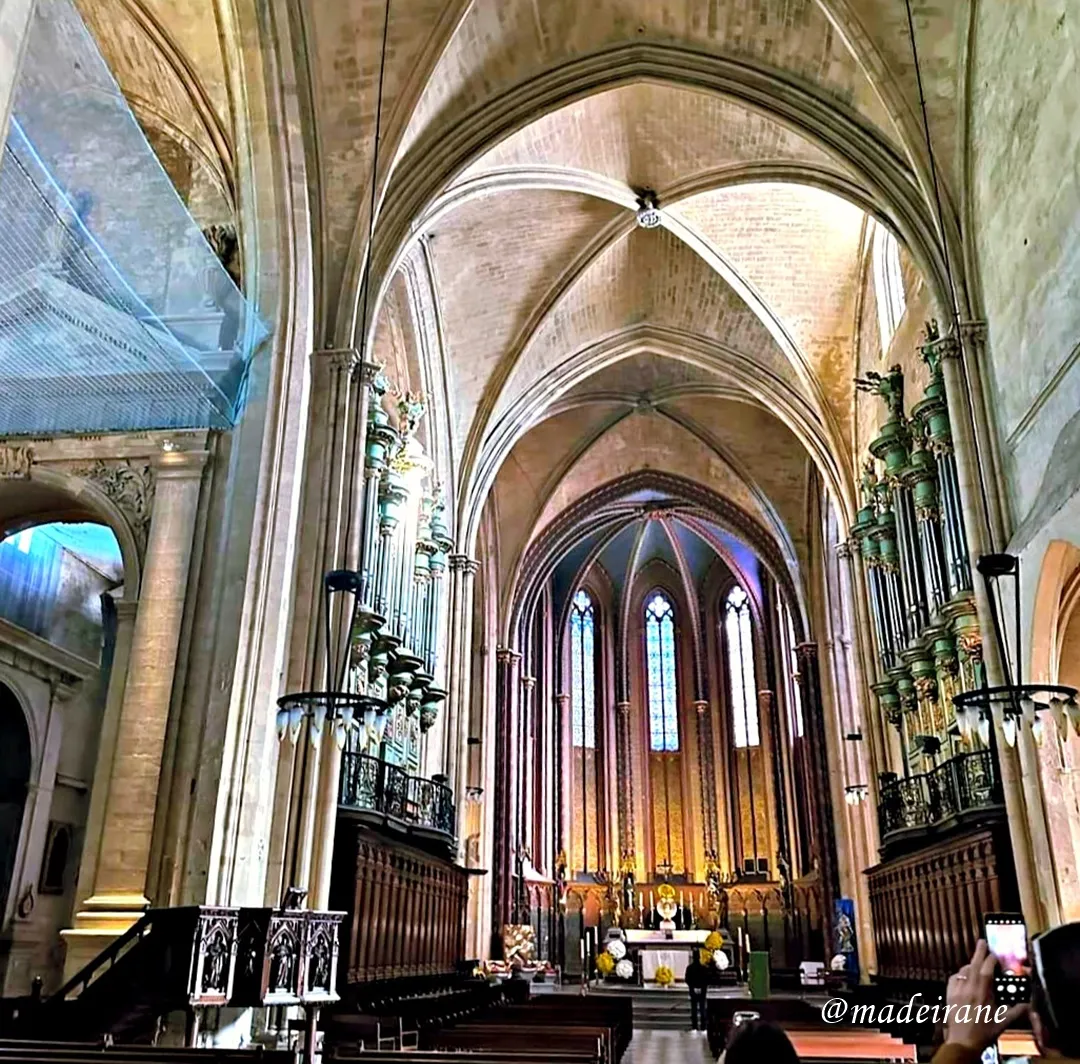

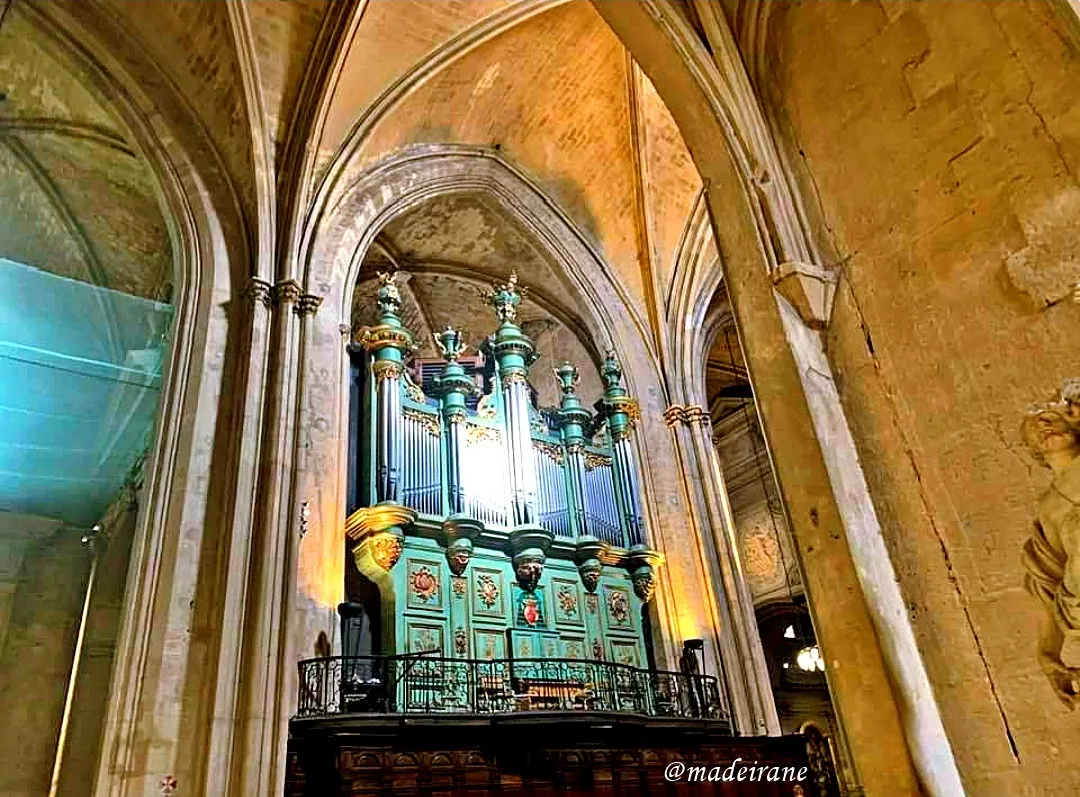
The characteristic stunning, in my opinion, applies to the stone decoration on the sarcophagus with the relics of St. Mitrius, and to the stone altar presented to the temple by a local noble man named Egosi. The sarcophagus, if I am not mistaken, dates from the 16th century, while the altar, which was dedicated to St. Anne, was made at the end of the 15th century.
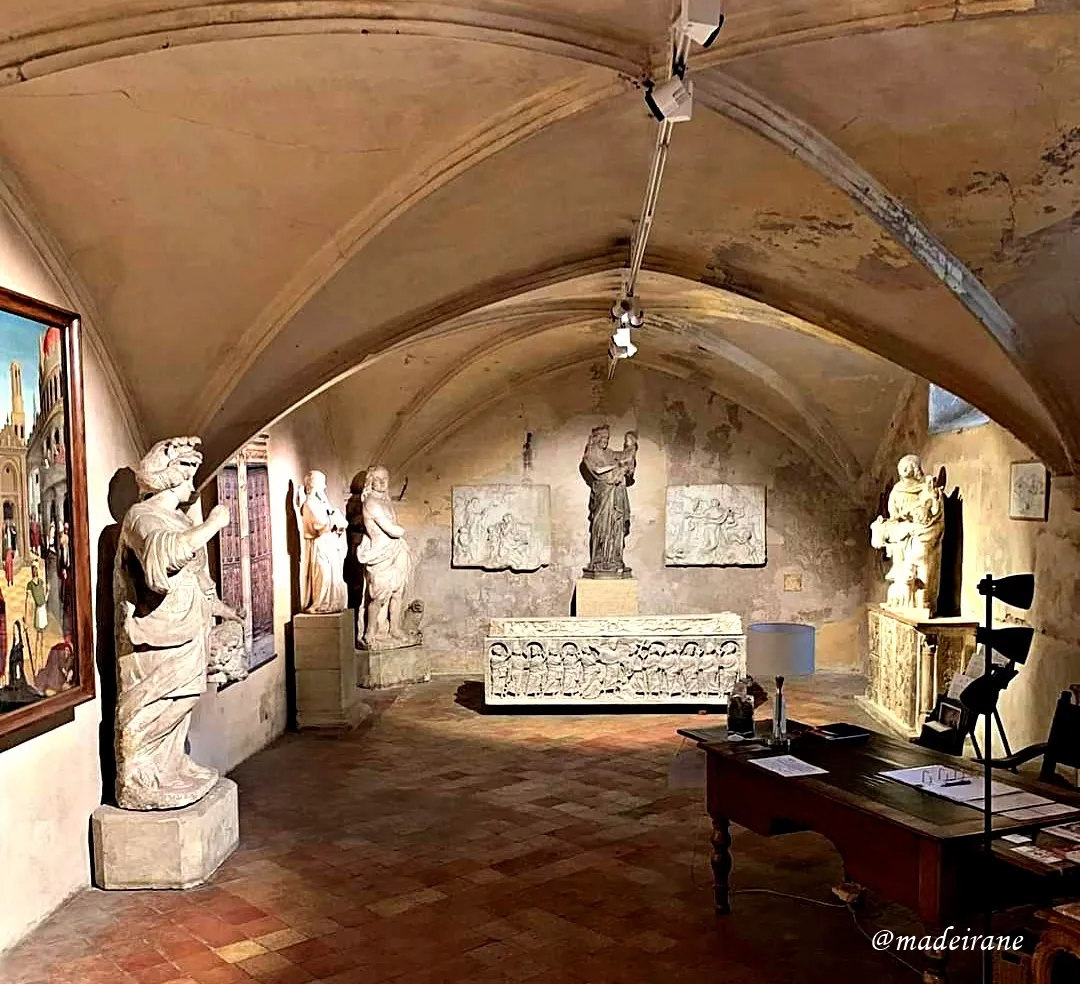
If I remember correctly, the sarcophagus dates back to the 16th century, and the altar dedicated to St. Anne, was made at the end of the 15th century.
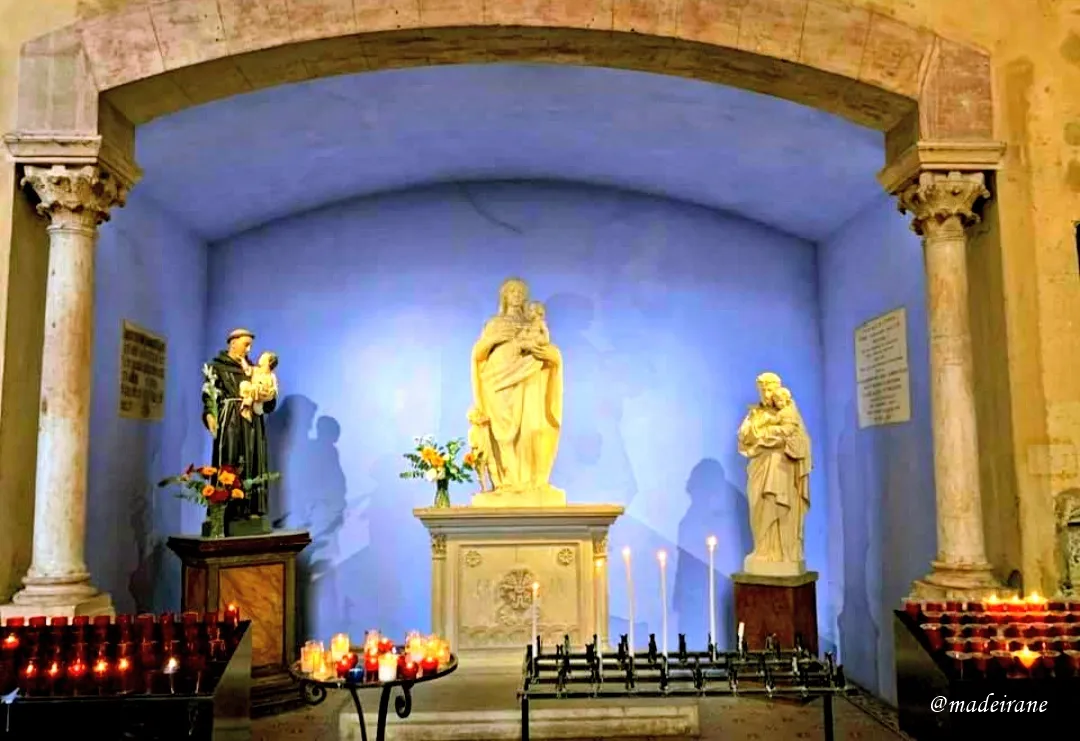
The oldest and most fascinating place inside the cathedral is its baptistery. These ancient columns, fountains with water brought from the same source, which were used by the ancient Romans. On the walls, like a symbol of the times, a beautiful painting from the 19th century - seven canvases devoted to seven church sacraments.
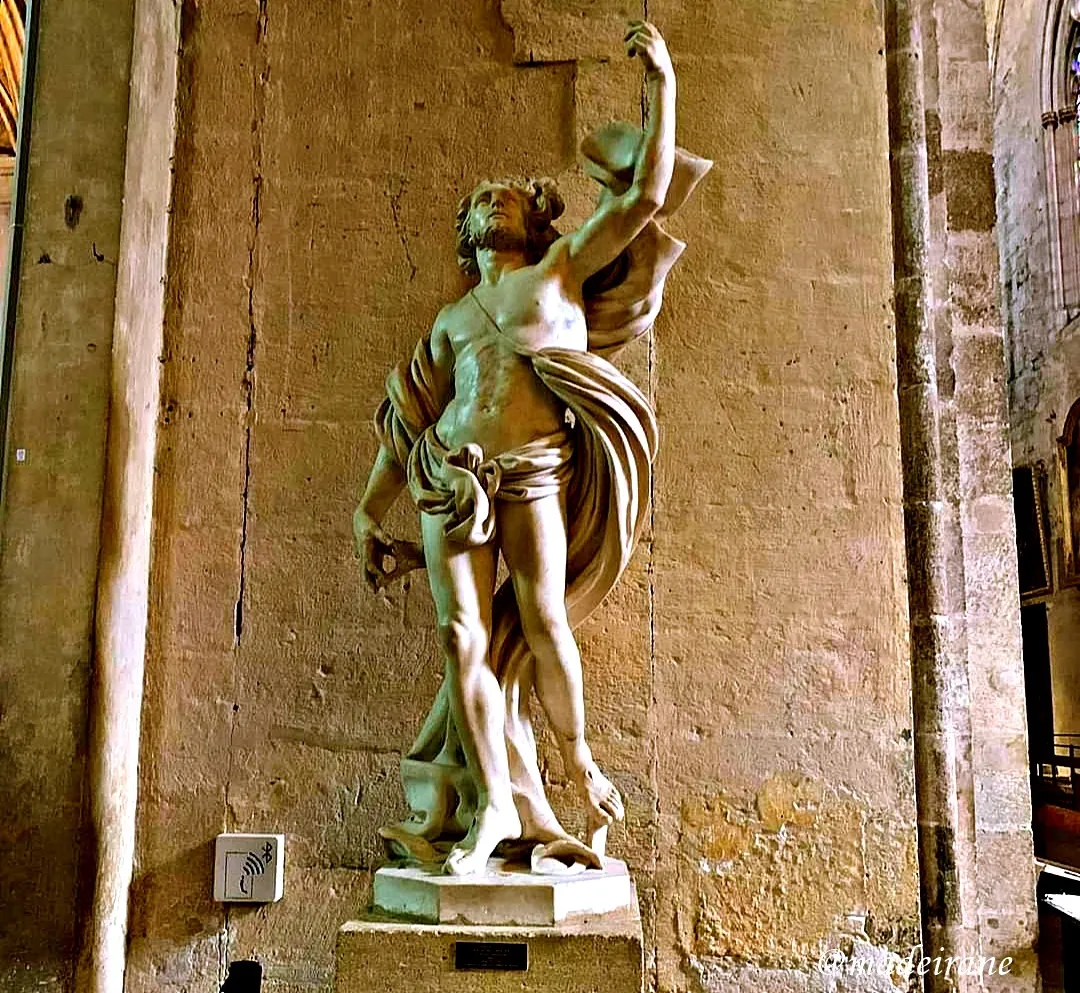
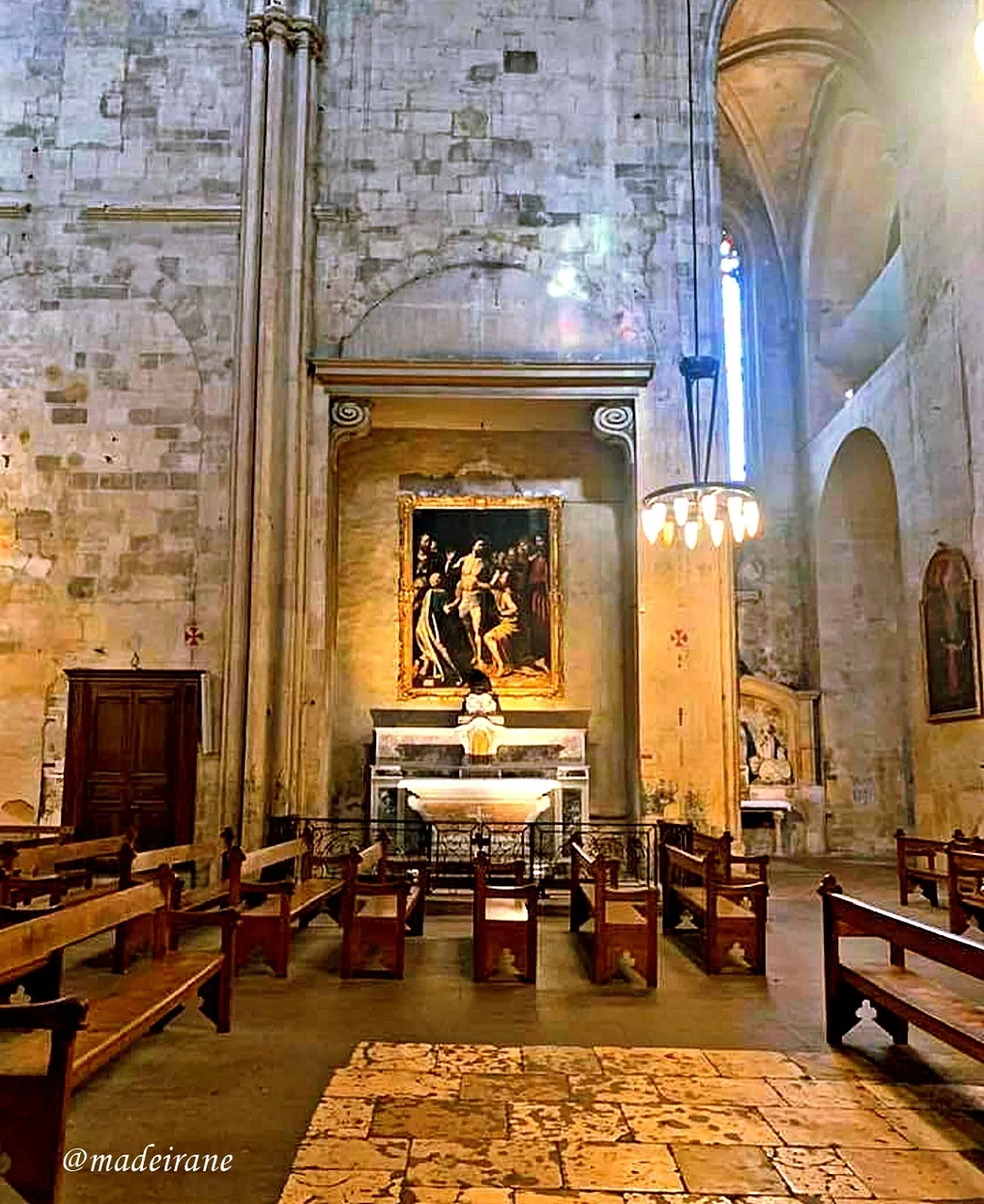
Not far from the cathedral - the ancient Roman baths of Sextia in a new shape. A modern SPA-complex functions in its place.
On the final note
Enjoy fountains at the beginning, middle and end of every street, in every square and park, near and between churches, chapels and town halls. Pigeons and children bathe in them, the dust of the day sinks in and the silhouettes of those taking pictures are reflected. They are as different as Aix-en-Provence itself.
We immerse ourselves in the special world of the squares of Aix-en-Provence with their kingdom of old fountains. And soon you start to understand Paul Cezanne, who said that when he is not in Aix, then "everything is in vain".

This is his city, his residence, a space for creative explorations and liberations, his landscapes and still lifes. The solid foundations of 20th century modern art were laid here. Walking slowly along the old city granite and counting the romantic shutters, I see and hear every second of the late evening under the July sky.
Translated from Lithuanian via DeepL (free version).
💝💝💝💝💝💝💝💝💝💝
With love, @madeirane
Photos are taken by me.
© 2023
Provanso siela
Kasmet, atėjus rudeniui, pradedu valyti pirmąsias dulkes nuo klajojančios vasaros atminties. Nes jos, kaip ir vynas, mėgsta ilgesnį senėjimo procesą. Šį kartą noriu papasakoti apie romantišką Provanso miestą, įsikūrusį kiek aukščiau Viduržemio jūros pakrantės, palikusį itin gilų įspūdį - Eks-en-Provansą, arba tūkstančio fontanų miestą.
Vienas maloniausių mano prisiminimų apie Prancūziją yra Provansas. Kvapnūs alyviniai kilimai ir levandų kilimėliai. Platanų alėjos. Ryškūs oleandrų, hibiskų ir bugenvilių plotai. Nenutrūkstamas cikadų choras nuo devintos ryto iki vienuoliktos vakaro. Šie čirškiantys nenuilstantys darbininkai nuo seno yra vienas iš Provanso prekės ženklų.
Taip pat prisimenu pastelinių spalvų kaimiškus namelius su langinėmis ir privaloma tuščia siena, saugančia nuo šalto mistralo. Kilmingas senovės romėnų griuvėsių linijas. Viduramžių vienuolynų didybę. Pilkai mėlynos uolos. Alyvmedžių giraitės, nesibaigiantys vynuogynai, sodai, sodai, daržai, daržai, laukai. Ženklai su rodyklėmis ir glaustais tekstais: vynas, abrikosai, persikai, melionai, slyvos, arbūzai... Aukštybinių pastatų balkonai, aptraukti tamsiais audiniais - visai kaip klajoklių namai.
Nuo pat pirmųjų pažinties su Aix-en-Provence minučių pajutau didelę simpatiją. Šiai simpatijai netrukdė karštis, kurio bijojau. Tačiau nepaisant stabilaus plius trisdešimt septynių ir daugiau, jaučiausi visai normaliai.
Aix istorija
Miestas minimas senovės kronikose nuo seniausių laikų ir, kaip rodo jo pavadinimas, stovi "ant vandenų". Tai reiškia, kad senovės romėnai šioje vietoje atrado keletą terminių šaltinių. Beje, tie šaltiniai tebenaudojami ir šiandien. Man buvo labai netikėta sužinoti, kad nuo XII a. iki Prancūzijos revoliucijos Provanso sostine buvo ne Marselis, o Aix-en-Provence. Tuo metu Provansas buvo nepriklausoma grafystė. Prancūzijos dalimi jis tapo tik XV a. pabaigoje. Karalius Renė tada valdė Provansą, įskaitant Eks-en-Provansą. Gyventojai jį vadina meno ir amatų globėju. Būtent šis jo valdymo laikotarpis paliko ryškų pėdsaką Aix-en-Provence istorijoje.
Jei skaičiuosime Aix istoriją nuo pirmojo liguvių genčių įsikūrimo, tai bus 2500 metų. Apskritai, graikai, romėnai, frankai, lombardai ir saracėnai paliko savo pėdsaką jos teritorijoje.
Kas man patinka Eks-en-Provane?
Aix-en-Provence yra orumo ir savigarbos jausmą turintis miestas. Stilingas, be jokių įkyraus pigaus blizgesio požymių. Aristokratiškas, bet be agresyviai demonstruojamos prabangos. O dvasia kažkuo primena senąjį XVII ir XVIII a. Paryžių, kuris, deja, buvo sugadintas ir prarastas.
Galingi seni platanai, elegantiški šiltų saulėtų spalvų smiltainio namai su elegantiškomis kaustytomis balkonų grotomis. Butikai, restoranai, parduotuvės, viešbučiai. Spalvingas ir visai ne erzinantis turgus, kuriame galima nusipirkti maišelių ir kremų su levandomis, levandų aliejaus, Marselio muilo, drabužių, antikvarinių ir senovinių daiktų, rankšluosčių, siuvinėtų Provanso simboliais, ir daug kitų įdomių dalykų. Ir į skirtingas puses besidriekiančios žavios siauros gatvelės.
Rotondės fontanas
Pasivaikščiojimą po miestą pradėjome nuo visų gidų rekomenduojamos pradžios vietos - nuo De Golio aikštės. Čia įrengtas monumentaliausias miesto fontanas - Rotondės fontanas. Netoliese yra mokama automobilių stovėjimo aikštelė ir turizmo informacijos centras, kuriame galima gauti nemokamų Aix istorinio centro ir apylinkių žemėlapių.
Rotondos fontanas buvo suprojektuotas XIX a. Fontano viršutinę dalį puošiančios skulptūrinės grupės sumanymas gana įdomus. Trijų marmurinių senoviniais drabužiais apsirengusių moterų (ir visas jas sukūrė skirtingi skulptoriai) akys nukreiptos į skirtingas puses. Teisingumą simbolizuojanti dama žvelgia į Mirabo bulvarą. Prekybai ir žemės ūkiui "vadovaujanti" dama žvilgsnį nukreipia į Avenue des Belges, vedančią į Marselį. O Bonaparto prospektas, vedantis į Avinjoną, patikėtas dailųjį meną simbolizuojančiai damai. Prie šių trijų gracijų prisidėjo gulbės, liūtai ir delfinai.
Rotondės fontanas neabejotinai gražus, tačiau man patiko kiti, ne tokie ryškūs, bet kartu ir ypatingi miesto fontanai, kurie buvusiai Provanso sostinei suteikia papildomo žavesio.
Nuo Rotondės fontano pasukome į senojo Aix-en-Provence širdį - Mirabeau bulvaru.
Tūkstančio fontanų miestas
Aix-en-Provence apibūdinamas kaip "tūkstančio fontanų miestas". Tačiau jei pažvelgtume į šių dienų realijas, turistiniame žemėlapyje pažymėtų fontanų iš kategorijos "būtina pamatyti" yra ne daugiau kaip pusė tuzino. Kitas dažnas Aix apibūdinimo štampas - "Sezano miestas". Tam nėra ko prieštarauti: čia gimė ir mirė vienas iš postimpresionizmo banginių.
Kadangi turistai paprastai pradeda pasivaikščiojimą Mirabo bulvaru nuo Rotondės fontano, pirmasis pakeliui pamatytas fontanas daugelyje gidų vadinamas Devynių patrankų fontanu.
Šiame pavadinime neieškokite jokių militaristinių šaknų. Jis buvo suteiktas dėl fontano veikimo principo: iš devynių vamzdžių trykštančio vandens. Prancūzų kalbos žodis "kanonas" turi daug reikšmių, įskaitant ne tik patranką, bet ir vamzdį. Jis buvo pastatytas XVII a. vietoje kito fontano, iš kurio anksčiau girdydavo galvijus. O pagrindiniai dabartinio fontano vandens vartotojai buvo vietinės vienuolės.
Egzotiškiausias ir labiausiai hipnotizuojantis Aix-en-Provence'o fontanas yra Samanų fontanas. Tai didžiulis žalias tirštų samanų kamuolys. Iš fontano trykštantis vanduo yra terminis ir vėsesniu metų laiku jį apgaubia garų debesis. Skulptūros, kaip ir ankstesnio fontano atveju, yra paslėptos po samanomis, tačiau tik ekspertai gali žinoti ir prisiminti, kaip jos atrodo.
Aix-en-Provence fontanai formaliai nepanašūs į jokius kitus. Jokių įspūdingų skulptūrų, iškilių dekoracijų, įmantrių raštų ant purkštukų. Tačiau šios šimtmečių senumo žalios kriauklės, iš po kurių trykšta terminio vandens čiurkšlės, apčiuopiama gilios, baimę keliančios senovės magija akimirksniu užburia sielą.
Toliau bulvare rasite dar vieną įdomų fontaną - Karaliaus Renė fontaną su statula. Jo valdymas pavertė Aix-en-Provence svarbiu to meto prekybos ir universitetų centru. Beje, Aix-en-Provence iki šiol laikomas vienu iš labiausiai studentiškų miestų Prancūzijoje. Valdant Renė, Provanse pradėta plačiai auginti muskatus ir migdolus. Paskutinis trubadūrų karalius Renė apsupo save puikiu dvaru, globojo poetus, dailininkus, muzikantus, mėgo rengti spalvingas daugiadienes šventes ir procesijas.
To paties Renė dėka Eks-en-Provanse atsirado ypatingas delikatesas - kalisonai, cukruoti migdolai su cukruotais vaisiais ir migdolų glajumi. Šis skanėstas pirmą kartą buvo sukurtas karališkoms vestuvėms kaip dovana būsimai karalienei.
Įžymios Aix-en-Provence lankytinos vietos
Bažnyčios viduje saulėje spindi nuostabūs vitražai. Čia radome nuostabią paveikslų kolekciją. Tiesą sakant, į šią bažnyčią mane atvedė ne tik Maltos riteriai ir gotikos stilius. Trečioji mano apsilankymo priežastis buvo Delakrua paveikslas "Nukryžiavimas", kuris bažnyčiai buvo padovanotas XX a. aštuntojo dešimtmečio pabaigoje.
Netoli bažnyčios, Precheurs aikštėje, yra dar vienas vaizdingas turgus, kuriame prekiaujama daržovėmis, vaisiais, garsiosiomis Provanso žolelėmis ir kitais įvairiais prieskoniais:
Nedidelė ir gana fotogeniška užuomina sprinteriams turistams: greitai pereiti iš Boulevard Mirabeau bulvaro į Place des Precheurs galima per Agar perėją, kuri tarsi "kerta" buvusio karmelitų vienuolyno pastatus.
Viena gražiausių aikščių Eksan-Provanse yra Alberto aikštė, suprojektuota pagal geriausias Paryžiaus ir Italijos tradicijas turtingam ir įtakingam piliečiui, kurio vardu ji pavadinta. Norėdamas įgyvendinti savo viziją, ponas d'Albertas turėjo supirkti visus toje vietoje esančius namus.
Į aikštę iš trijų pusių žvelgia XVIII a. pastatyti barokiniai pastatai su rokoko stiliaus dekoracijomis. O elegantiškas, bet samanomis apaugęs fontanas atsirado po daugelio dešimtmečių - po aikštės savininko mirties (tiksliau, po jo nužudymo).
Ir vėl pasineriame į nuostabių Aix-en-Provence gatvelių labirintą. Vienoje iš jų vilioja gražus senas sargybos bokštas su laikrodžiu ir varpu ant stogo. Ėjome link rotušės, praėjome Rišelmo aikštę, kurioje šurmuliavo dar vienas turgus. Rotušės balkone šalia Europos Sąjungos ir Prancūzijos vėliavų plevėsuoja Provanso vėliava. Rotušė, kaip ir bokštas, pastatyta XVII amžiuje.
Šalia rotušės stovi įspūdingas buvusios grūdų biržos pastatas su alegorinėmis figūromis ant frontono, simbolizuojančiomis Ronos upę ir Durantą. Ir jei ne iš anksto perskaityta literatūra, mintyse būčiau "patalpinęs" biržą į šį pastatą.
Kitos gražios gatvės gale pasirodė aukšta ir grakšti balta Šventojo Išganytojo katedros karūna.
Šventojo Gelbėtojo katedra
Kalbėdamas apie vietinę Šventojo Išganytojo katedrą daug kartų pavartosiu žodį "stulbinanti".
Tikrai nuostabu, kad Eks-en-Provansas išsaugojo lobį, kuriame gyvi visi nuo V iki XVII a. egzistavę architektūros stiliai, t. y. skirtingi katedros statybos etapai. Tai romaninis, gotikinis ir barokinis stiliai, taip pat Senovės Romos palikimas - sienos ir kolonų fragmentas, kurį galima pamatyti katedros krikštykloje.
Charakteringas stulbinantis, mano nuomone, yra akmeninis sarkofago su šventojo Mitrijaus relikvijomis dekoras ir akmeninis altorius, kurį šventyklai padovanojo vietinis kilmingas vyras Egosi.
Sarkofagas, jei neklystu, datuojamas XVI a., o altorius, skirtas šventajai Anai, pagamintas XV a. pabaigoje.
Tačiau didžiausią įspūdį katedroje palieka N. Fromano triptikas "Nesudegintas piliakalnis". Tai ne tik puikus XV a. religinės tapybos pavyzdys, bet ir gražus Provanso karaliaus Renė Dobrės atminimas.
Renė užsakyto triptiko lapuose pavaizduotas jis pats ir jo antroji žmona Žana de Laval. Na, o centrinę triptiko dalį, žinoma, užima garsiausias Senojo Testamento siužetas - kai pasirodo Mozė, apimtas ugnies, bet likęs nesužeistas erškėčių krūmas, iš kurio į jį kreipiasi Go Motina, ragindama vesti tautą į Pažadėtąją žemę. Ant jo dailininkas "pasodino" Mergelę Mariją su kūdikiu.
Jei gerai pamenu, sarkofagas datuojamas XVI a., o altorius, skirtas šv.
Kaip jau minėjau, seniausia ir žaviausia katedros vidaus vieta yra jos krikštykla. Tai senovinės kolonos, fontanai su vandeniu, atvestu iš to paties šaltinio, kurį naudojo senovės romėnai. Ant sienų, tarsi laikmečio simbolis, kabo graži XIX a. tapyba - septynios drobės, skirtos septyniems bažnytiniams sakramentams.
Netoli katedros - naujo pavidalo senovės romėnų Seksijos pirtys. Jos vietoje veikia modernus SPA kompleksas.
Paskutinė pastaba
Pasigrožėkite fontanais kiekvienos gatvės pradžioje, viduryje ir pabaigoje, kiekvienoje aikštėje ir parke, prie bažnyčių, koplyčių ir rotušių bei tarp jų. Juose maudosi balandžiai ir vaikai, nusėda dienos dulkės ir atsispindi fotografuojančiųjų siluetai. Jie tokie pat skirtingi kaip ir pats Eks-en-Provansas.
Pasineriame į ypatingą Aix-en-Provence aikščių su jų senųjų fontanų karalyste pasaulį. Ir netrukus pradedi suprasti Paulį Cezanne'ą, kuris sakė, kad kai jo nėra Aix, tada "viskas veltui".
Tai jo miestas, jo rezidencija, kūrybinių ieškojimų ir išsilaisvinimo erdvė, jo peizažai ir natiurmortai. Čia buvo padėti tvirti XX a. modernaus meno pamatai. Lėtai vaikščiodamas senamiesčio granitu ir skaičiuodamas romantiškas langines, matau ir girdžiu kiekvieną vėlyvo vakaro sekundę po liepos dangumi.
💝💝💝💝💝💝💝💝💝💝
Su meile, @madeirane
Nuotraukos darytos mano.